CHARLESTON’S WINDOW BOXES
Can we all agree that no city does window boxes like Charleston? Whenever I visit, I prowl the neighborhoods looking for the most recent gorgeous window box plantings. The ever-expanding availability of subtropical and tropical plants in nurseries these days allows those of us in temperate zones to enjoy such exotics in our containers and gardens during the upcoming warm months. I’m hoping that these beautiful Charleston containers will provide inspiration as we enter the “annuals” season. I apologize in advance that I can’t identify all the plants used in these containers, but I’m giving it a shot!
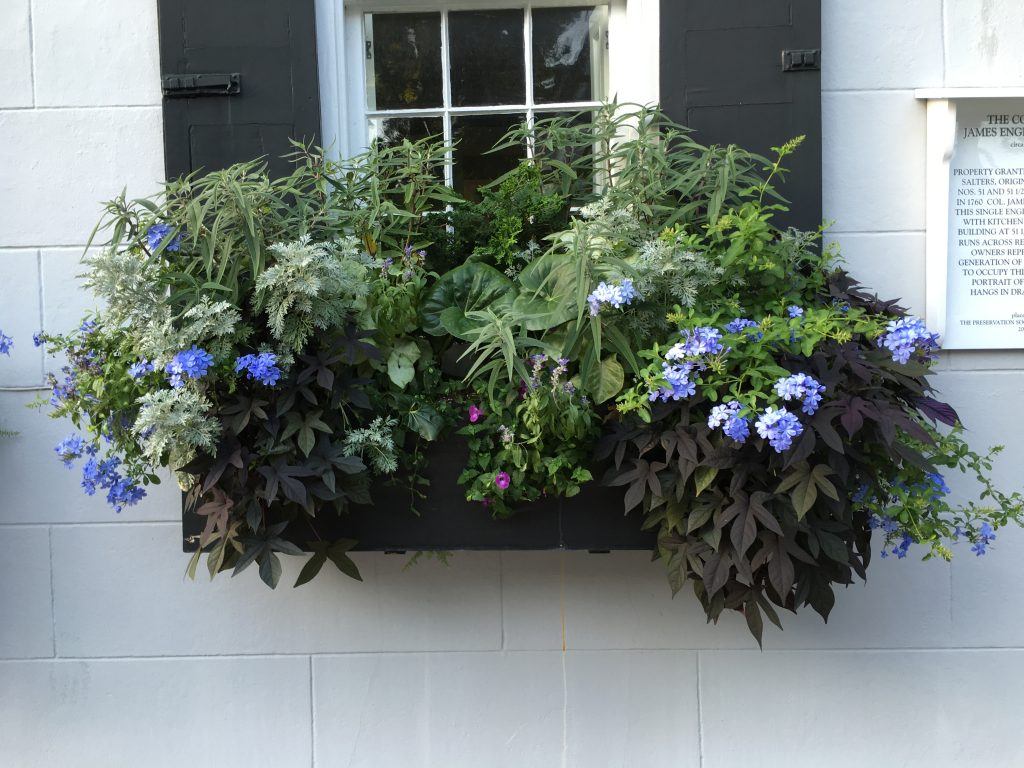
This cool-toned box features plumbago, dusty miller, solanum, ligularia, and “Blackie” sweet potato vine.
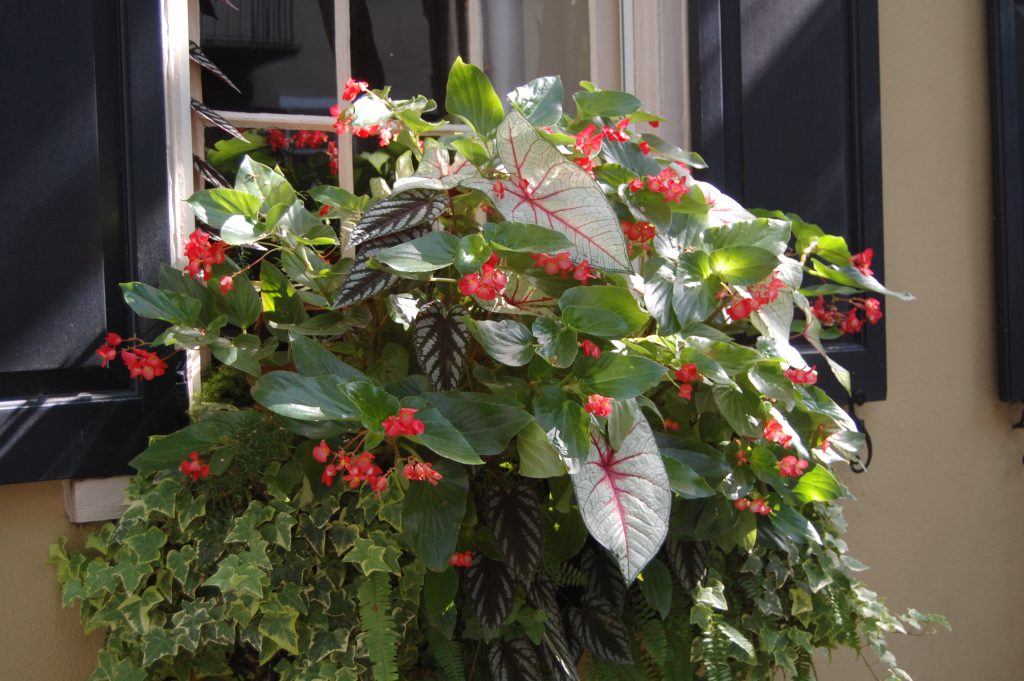
From cool to hot — The red bloom of the begonia is repeated in the veining of the caladiums, with variegated ivy tying it all together.
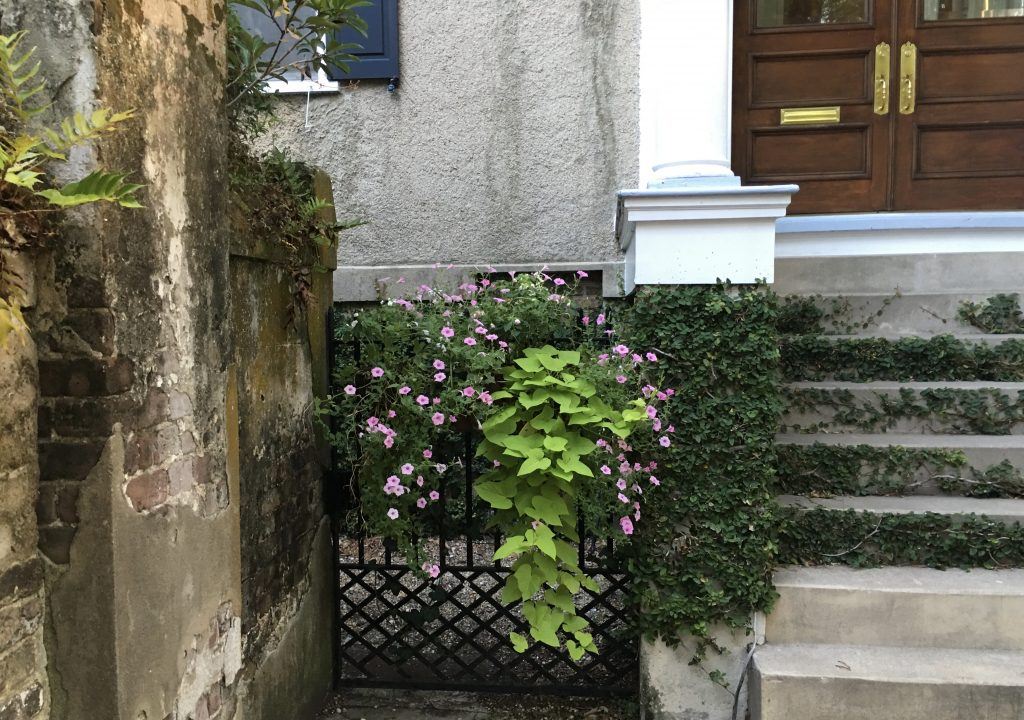
Imagine this streetscape without the creeping fig on the steps and the simple window box (with sweet potato vine and calibrachoa) on the gate. It would be stark indeed.
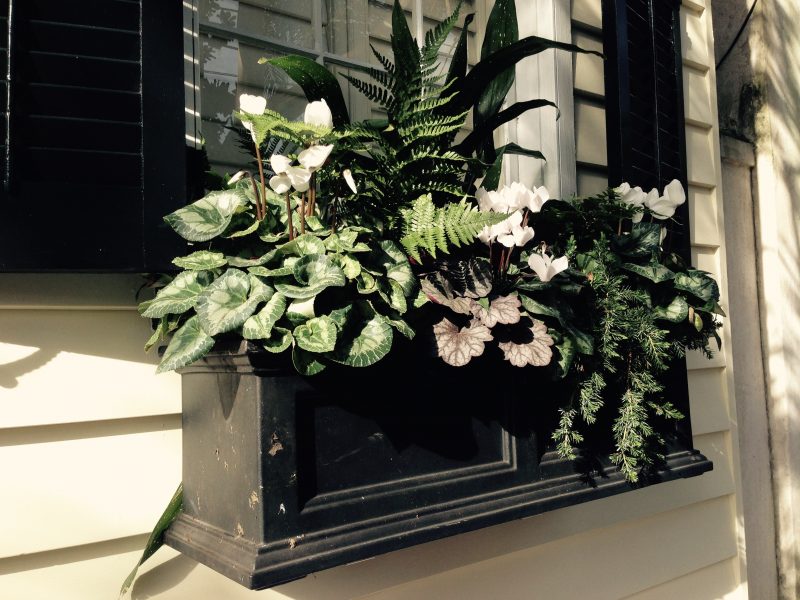
The variegated cyclamen and heuchera foliage in the picture above complement the dark shutters and window box. The spilling conifer and fern add to the dark mood.
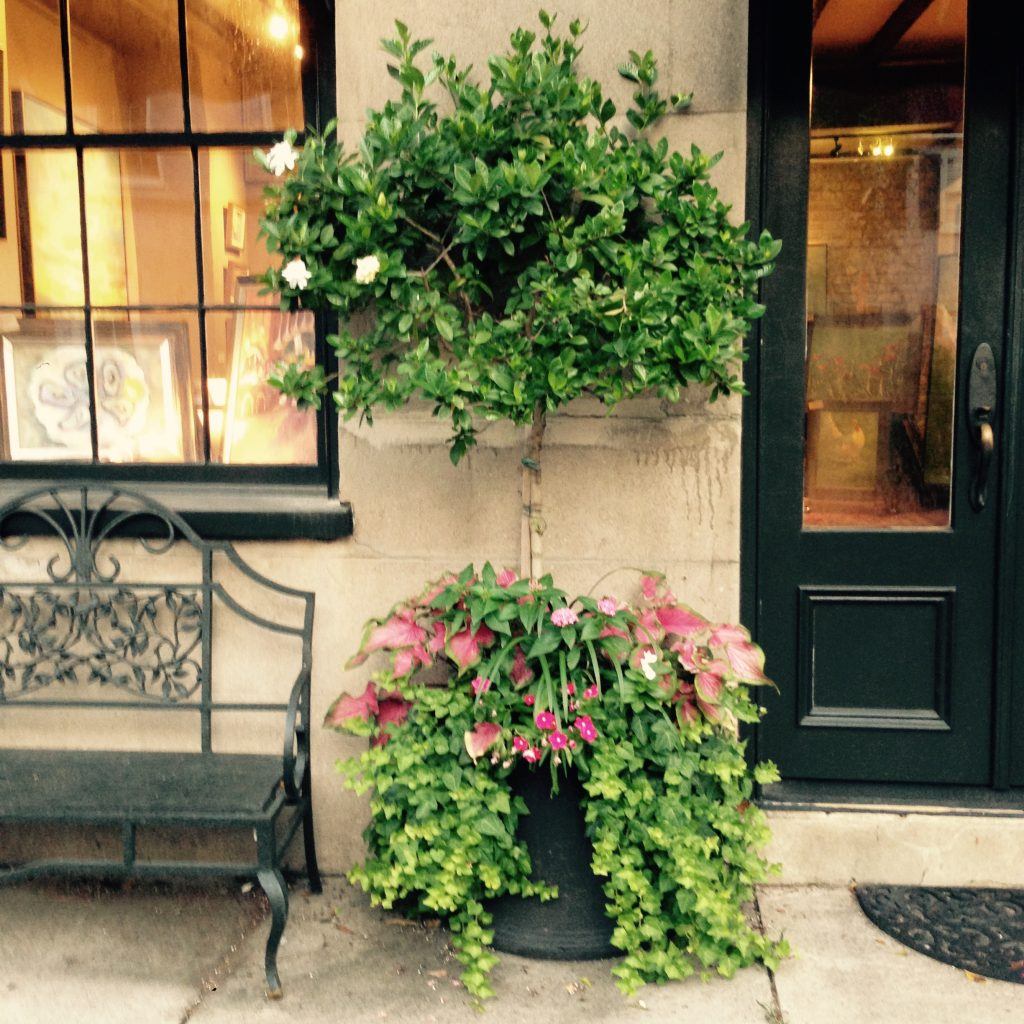
This standard Gardenia is set off nicely by the base annual and ivy plantings.
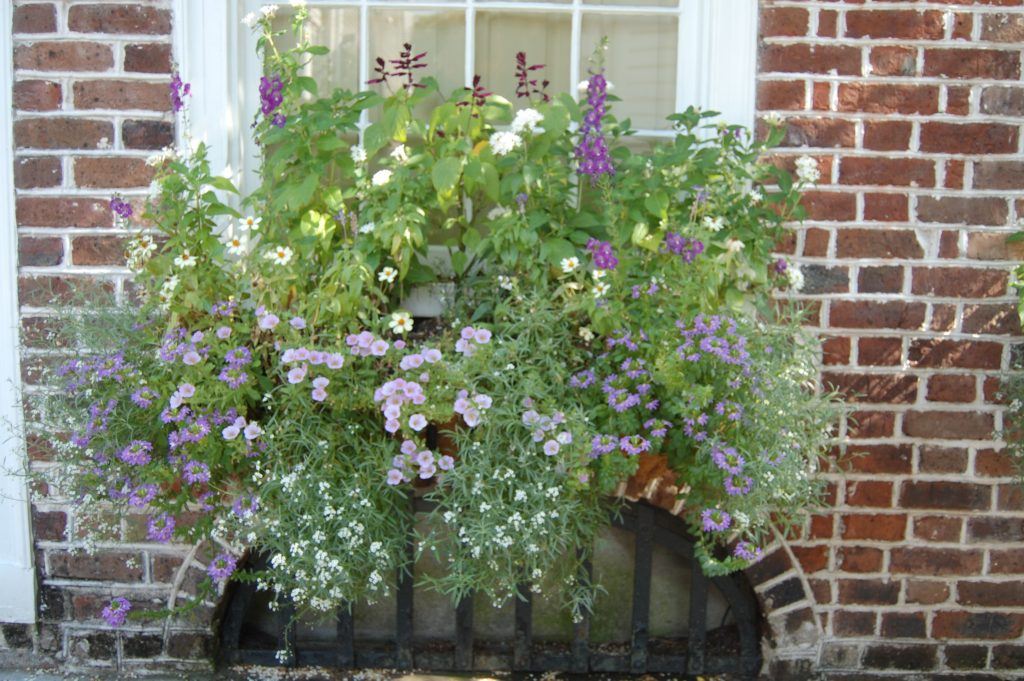
All the window boxes, with the exception of the one above and below, are mounted on a neutral background. Brick foundation is a bit more challenging, but these boxes pull it off, I think. Above is a soft range of blues and whites, including salvia, sweet alyssum, scaevola, petunia, and maybe some angelonia.
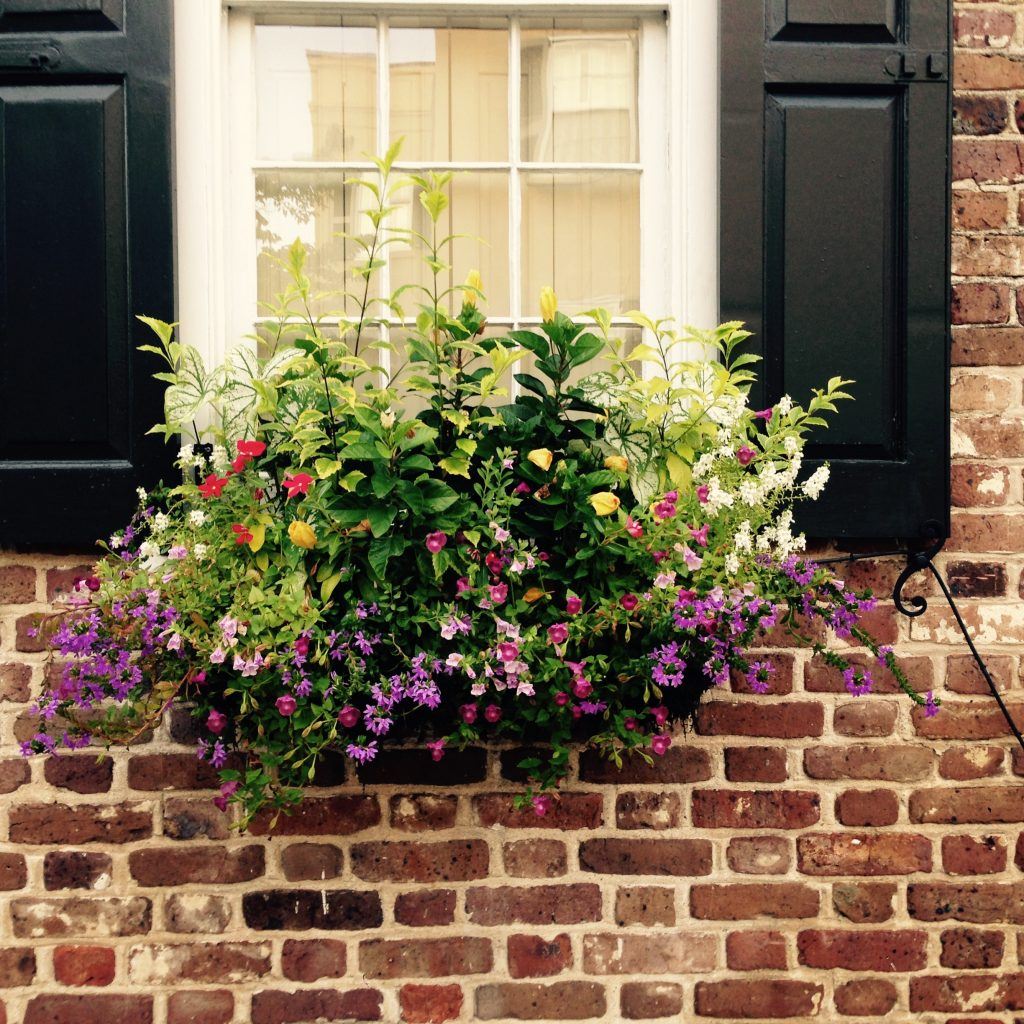
A livelier palette works against this brick foundation. I spy angelonia, calibrachoa, scaevola, solanum, salvia, hibiscus, and caladiums, among other plants.
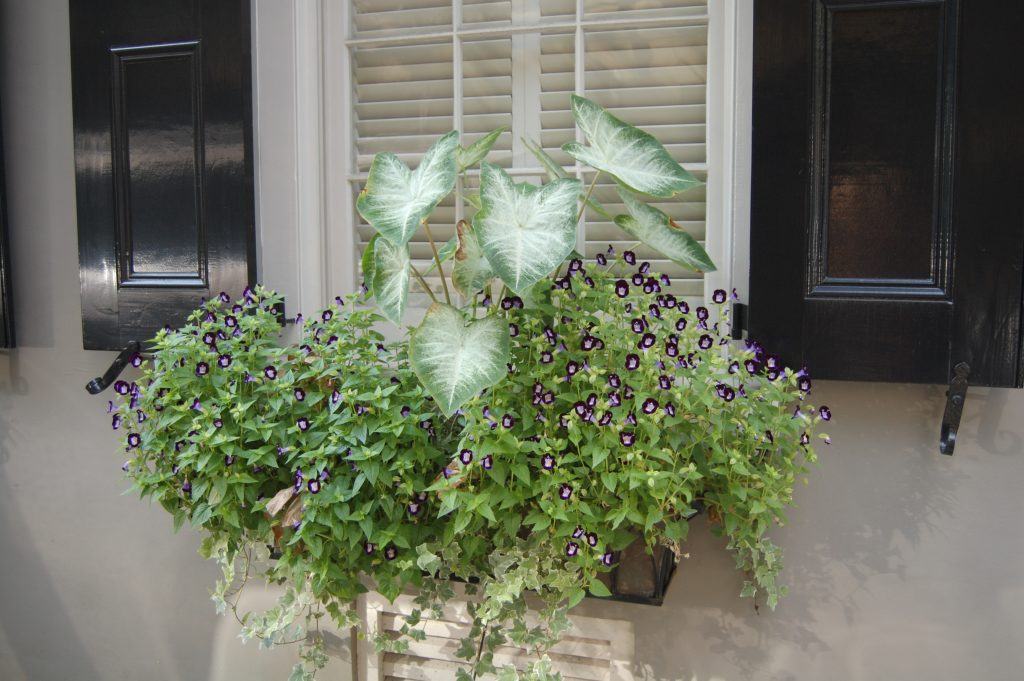
A simple but effective combination of caladiums, ivy and . . .
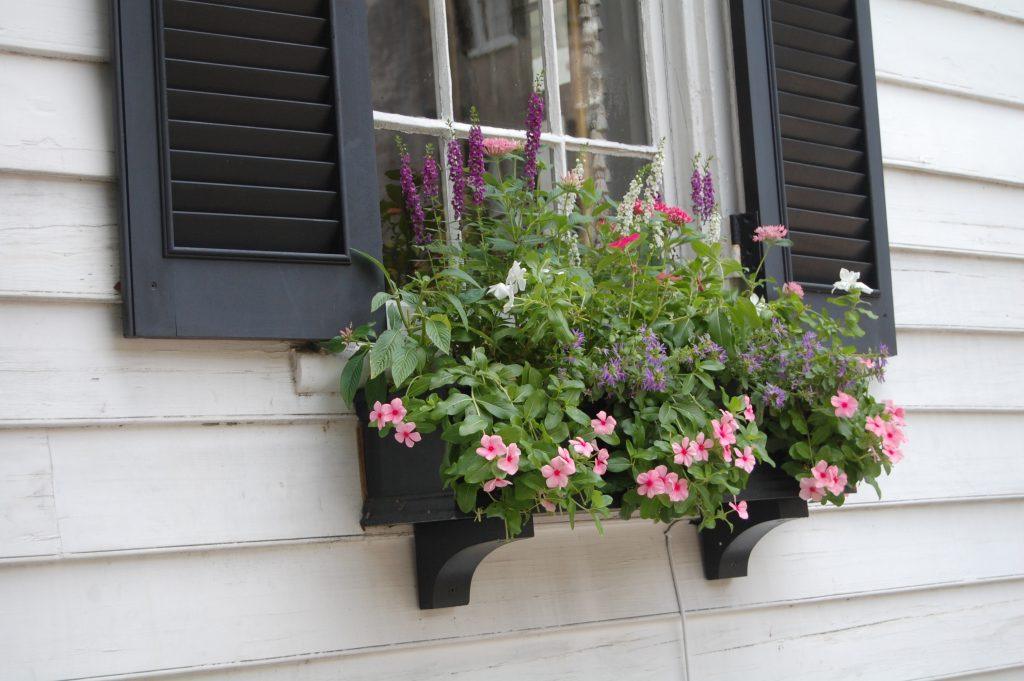
Note the ingenious watering mechanism in this window box (above and below). The cord feeding the box is painted black when against the box, white against the clapboard, then black again as it snakes behind the lattice at the base toward its water source.
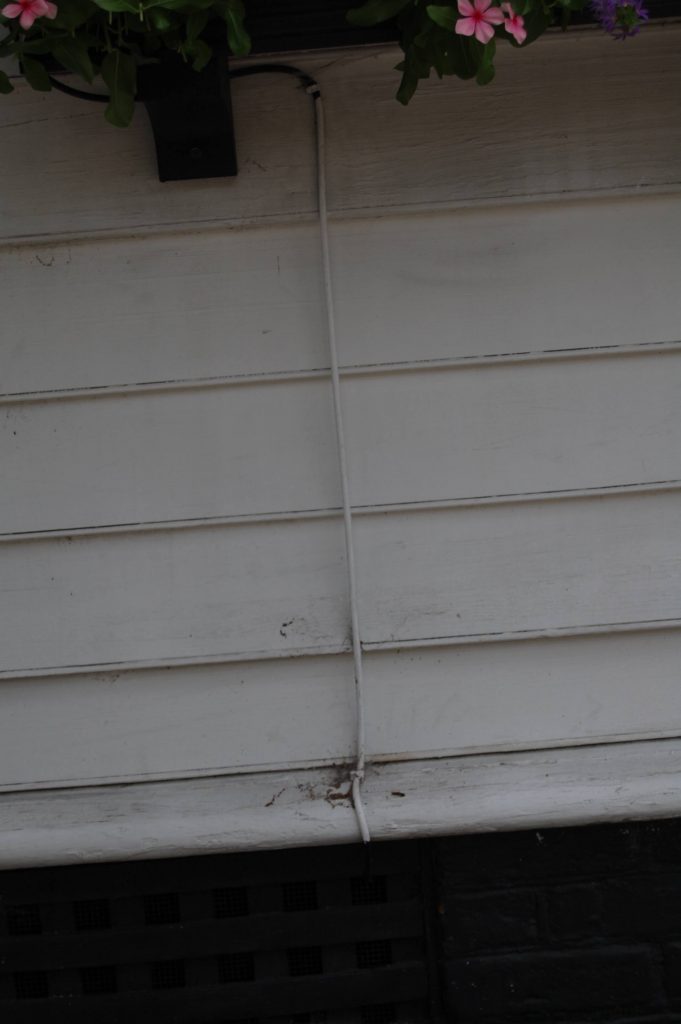
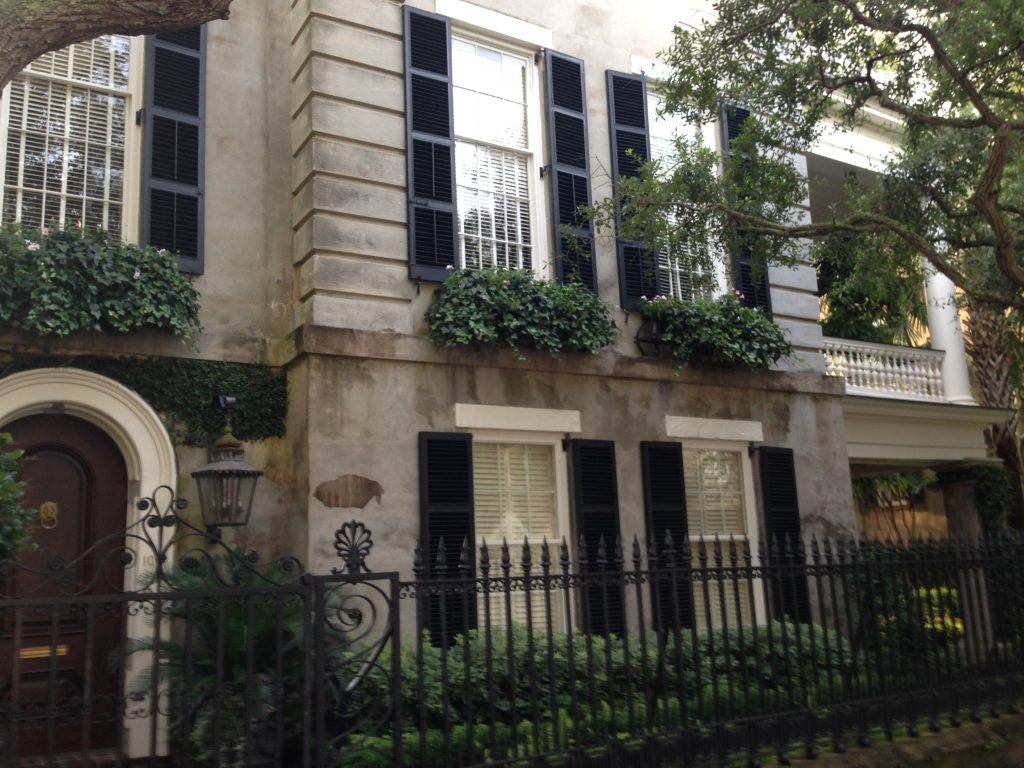
The window boxes above and below take their cue from the elegant architecture. No need to compete here with a riot of color. Plenty of green, with a hint of color, complements the sophisticated facade.
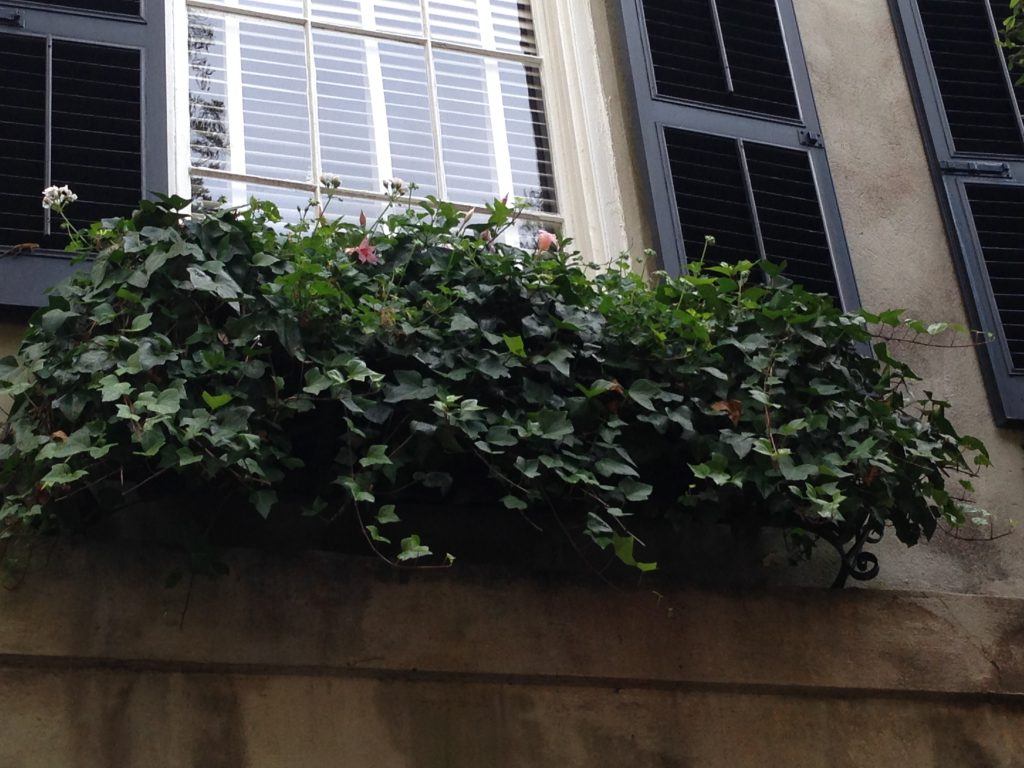
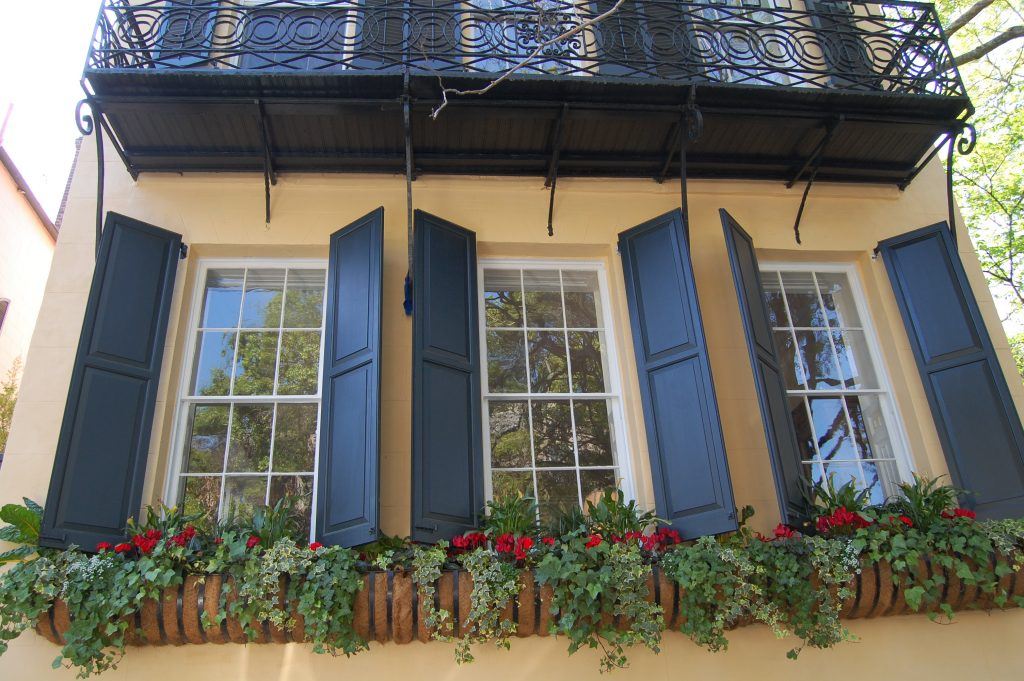
I love the one mega-box spanning the three windows — a Mediterranean feel.

The final three photos are of one residence in three different years. The plant palette takes full advantage of the home’s gray shades. Above, begonia, fern, setcreasea ‘Purple Queen’ and caldium, among other plants, spill out of the box.
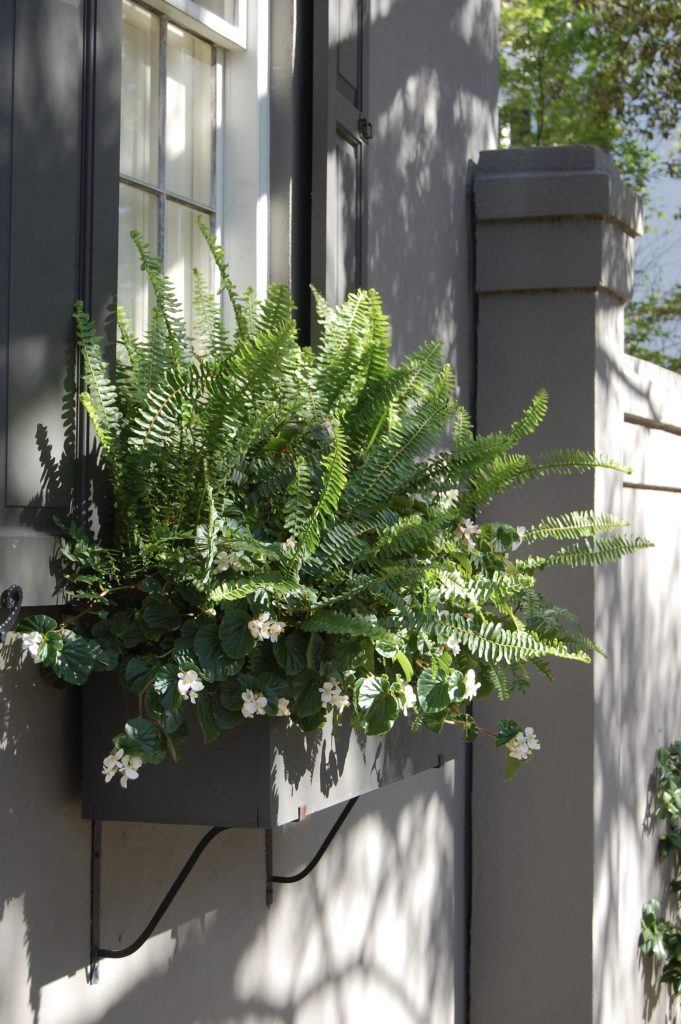
This is so simple, but so effective — white begonias and Kimberly fern.
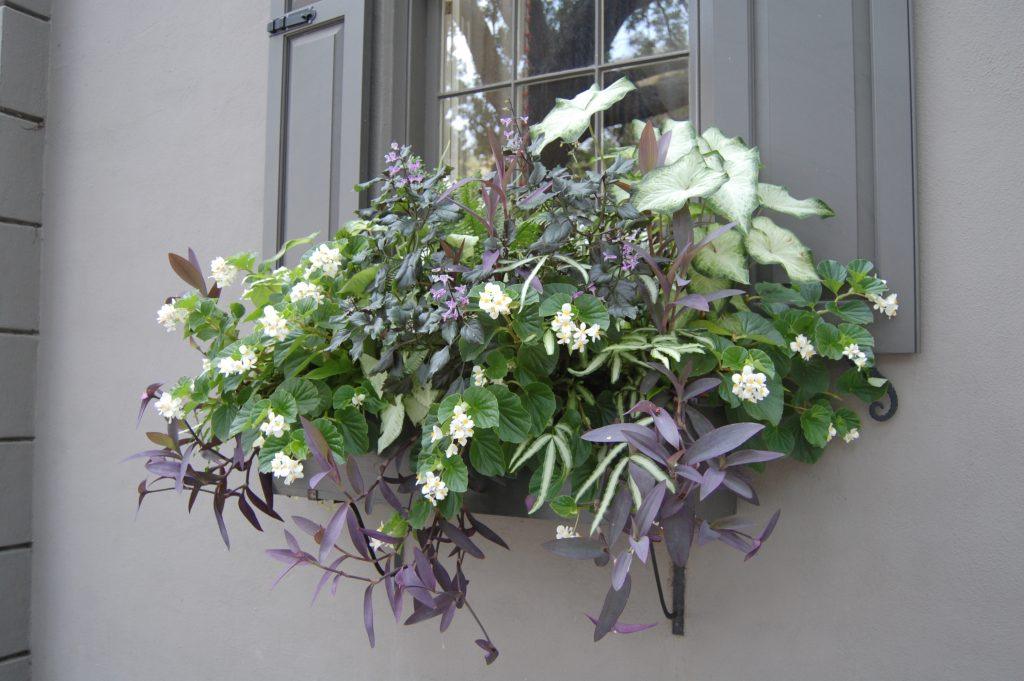 This year, the box uses succesful plants of the past, then adds Mona Lavender (Plectranthus).
This year, the box uses succesful plants of the past, then adds Mona Lavender (Plectranthus).
Frost date in Richmond has passed. It’s time to start creating your own masterpieces!
[custom-related-posts title=”Related Posts” none_text=”None found” order_by=”title” order=”ASC”]
BEFORE AND AFTER: THE ENGLISH GARDEN
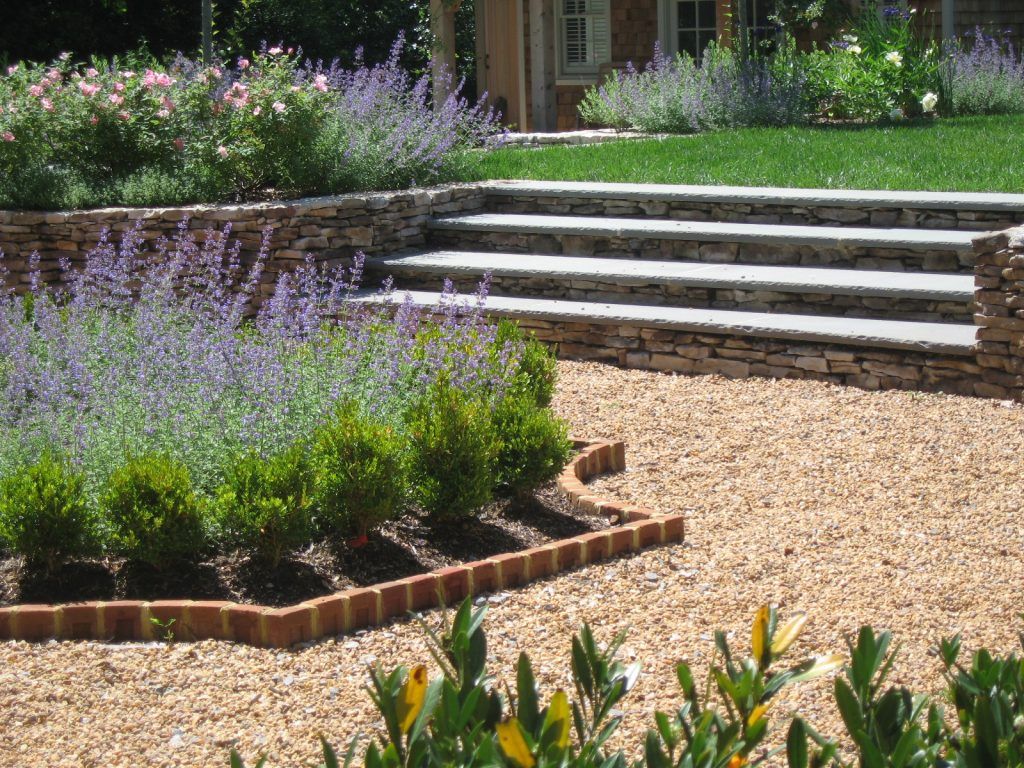
Before and Afters are an effective tool to help gardeners see the possibilities for transformations in their own garden spaces. This B and A takes me back several years to a memorable collaboration with Ben and Loretta English. Ben and Loretta, who have great insight and taste, brought out the best in all of those who renovated the Englishes’ gardens and they were an absolute delight to work with.
THE FRONT YARD
The front renovation began with a focus on the front door. Loretta, who has a keen eye for design and a great sense of scale and proportion, felt that the front entrance needed a stronger presence to balance the facade, and so framed the door with a deeper coved hood. Taking a cue from this enhancement, we took the opportunity to add a broad, generous landing and a U-shaped drive to further open up the entry.
BEFORE:
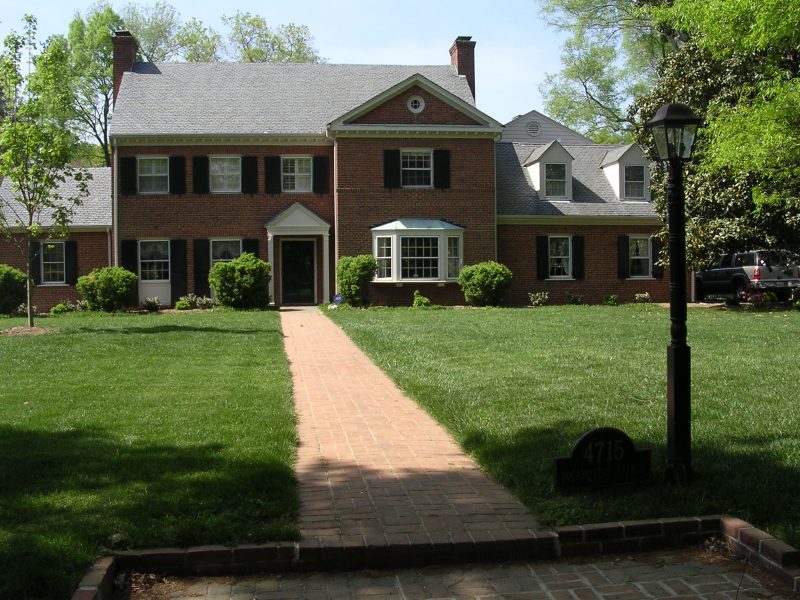
AFTER:
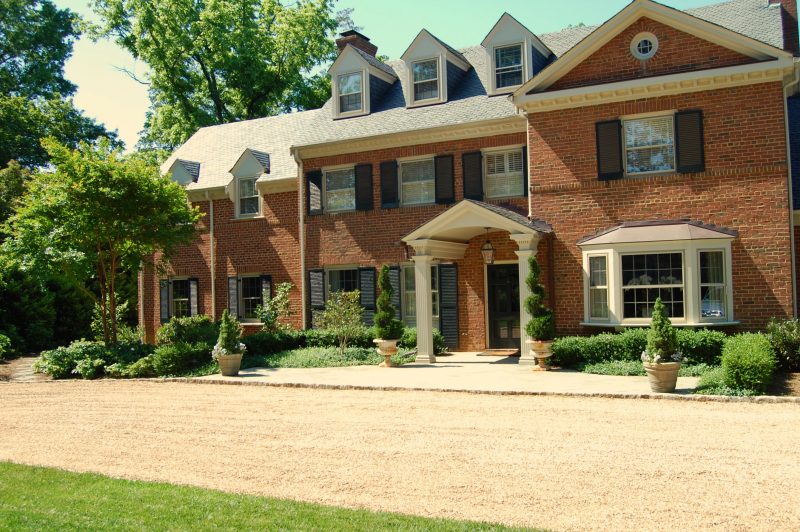
The landing is paved with select bluestone in a stacked stone herringbone pattern, and bordered by brick. A small boxwood hedge (Buxus ‘Justin Brouwer’) and Small Periwinkle (Vinca minor) frame the landing.
Planting a U drive’s island can be tricky. Rarely is the island on axis with the front door. Here, we planted an S curved laurel hedge (Prunus laurocerasus ‘Otto Luyken’), the apex of one curve in line with the center of the front door, with sweeps of hydrangea (Hydrangea macrophylla ‘Nikko Blue’) nestled in the curves. On the street side, we planted a ground plane of pachysandra (Pachysandra terminals).
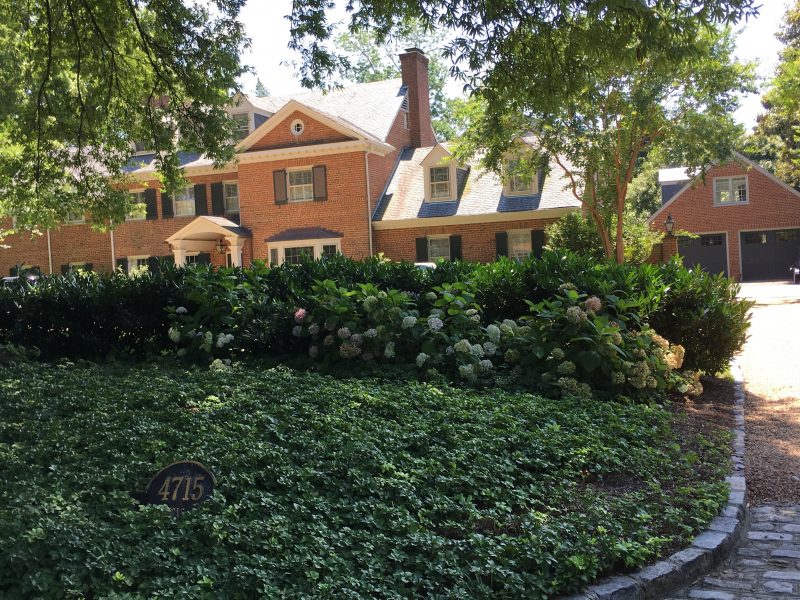
We paved the driveway in brown crusher run and edged the driveway in cobblestone, with a cobblestone apron at the street’s entrance.
To make way for the drive, we removed a a magnolia, and added a brick wall to hide the service and parking area.
BEFORE:
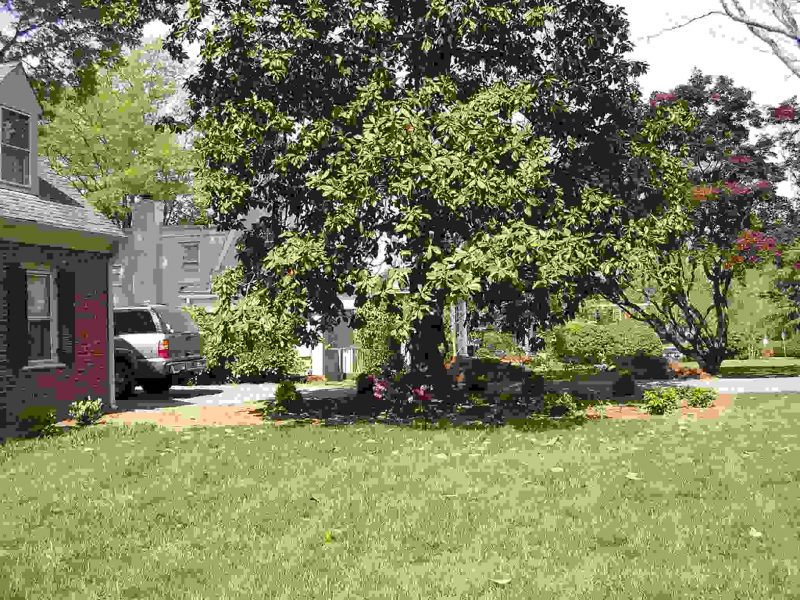
AFTER:
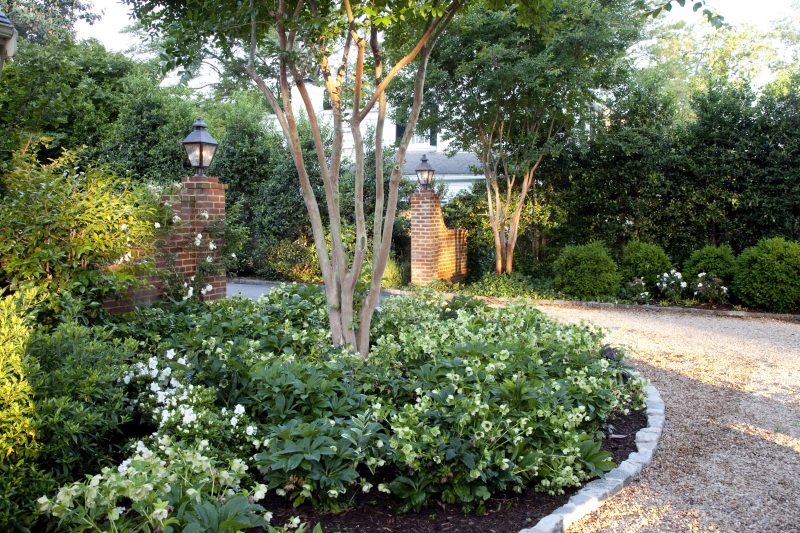
We softened the edges of the house by planting Crapemyrtles (Lagerstroemia indica ‘Natchez’) on the two corners of the house. We kept the foundation planting simple, with a mass of evergreen Lenten Rose (Helleborus orientalis), Gardenia (Gardenia jasminoides ‘Frostproof’), and Camellia sasanqua. White Dawn climbing rose drapes over the new wall.
BEFORE:
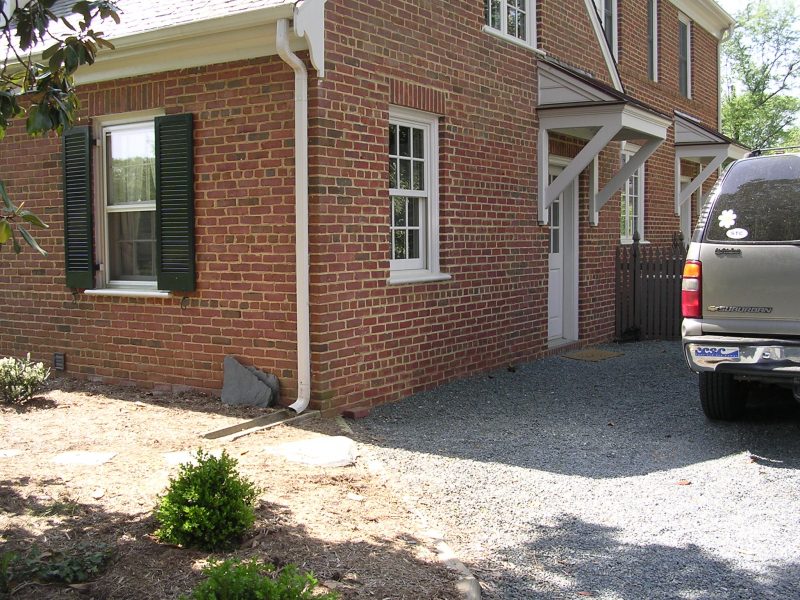
AFTER:
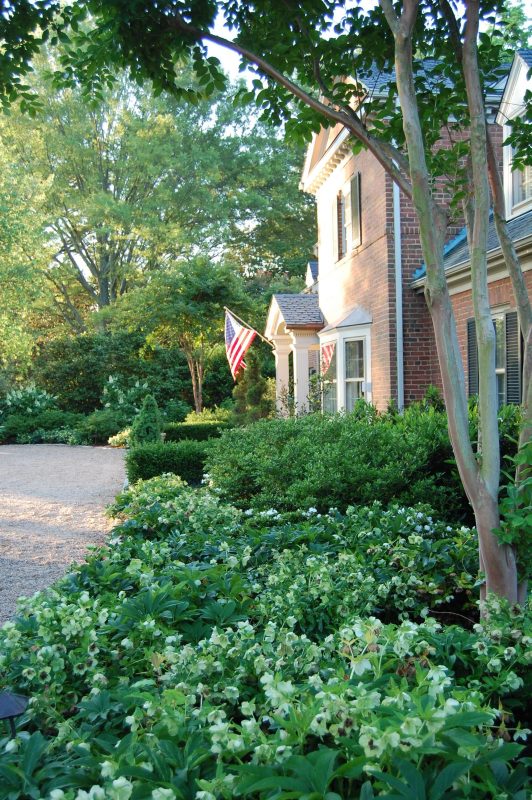
BEFORE:
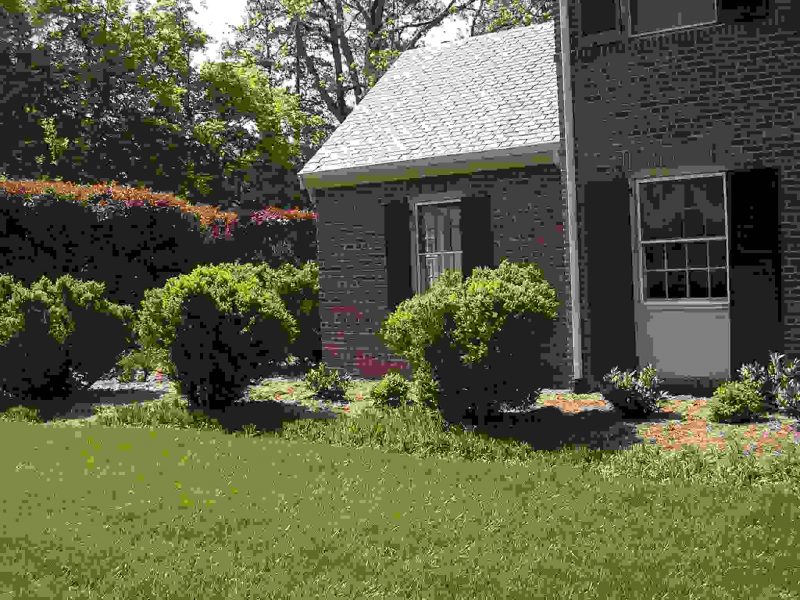
AFTER:
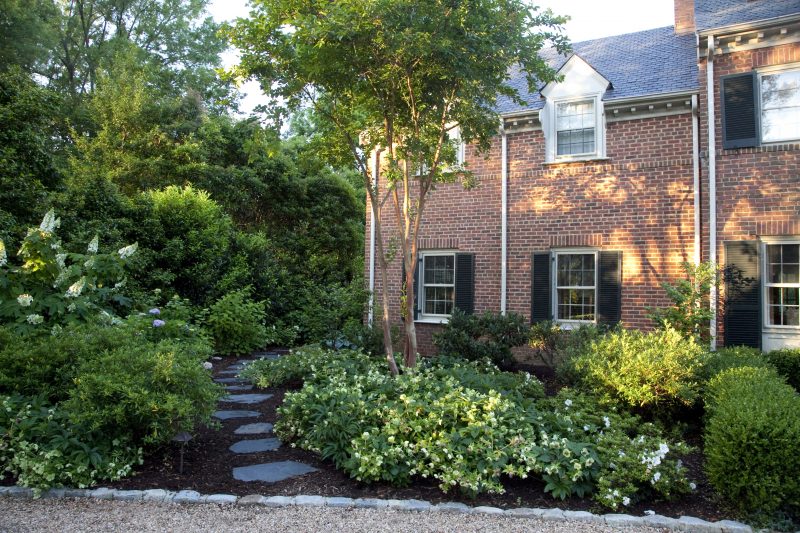
On the east side, we separated the foundation plantings from those along the east side of the driveway with a stepping stone path. We loosened up the plant palette with Oak Leaf Hydrangea (Hydrangea quercifolia), Prague Viburnum (Viburnum pragense), Variegated Solomon’s Seal (Polygonatum odoratum variegatum) and ferns. We planted Japanese Maples (Acer palmatum) at each entrance to the driveway.
THE BACKYARD
We had a lot of fun in the back. The Englishes had decided to add a pool, and Ben asked whether we could use the excavated dirt to add elevation to the garden. Well. That was music to my ears. I LOVE to use the slightest grade change as an opportunity to add garden elements such as walls and steps. These features transform a garden, giving it structure, definition and depth, and it drove the design for the Englishes’ backyard.
We divided the garden into three north-south sections, and then within those sections created several distinct spaces. The gardens are arranged using strong axial lines, both north-south and east-west, so that each space beckons from another.
The East Section
The pool and pool house were placed in the furtherest east section, and we left it the same grade as the house, as we needed to tie in circulation with little room to maneuver. We used select bluestone in a diamond pattern for the pool terrace, and edged it with brick, to complement the brick house.
BEFORE:
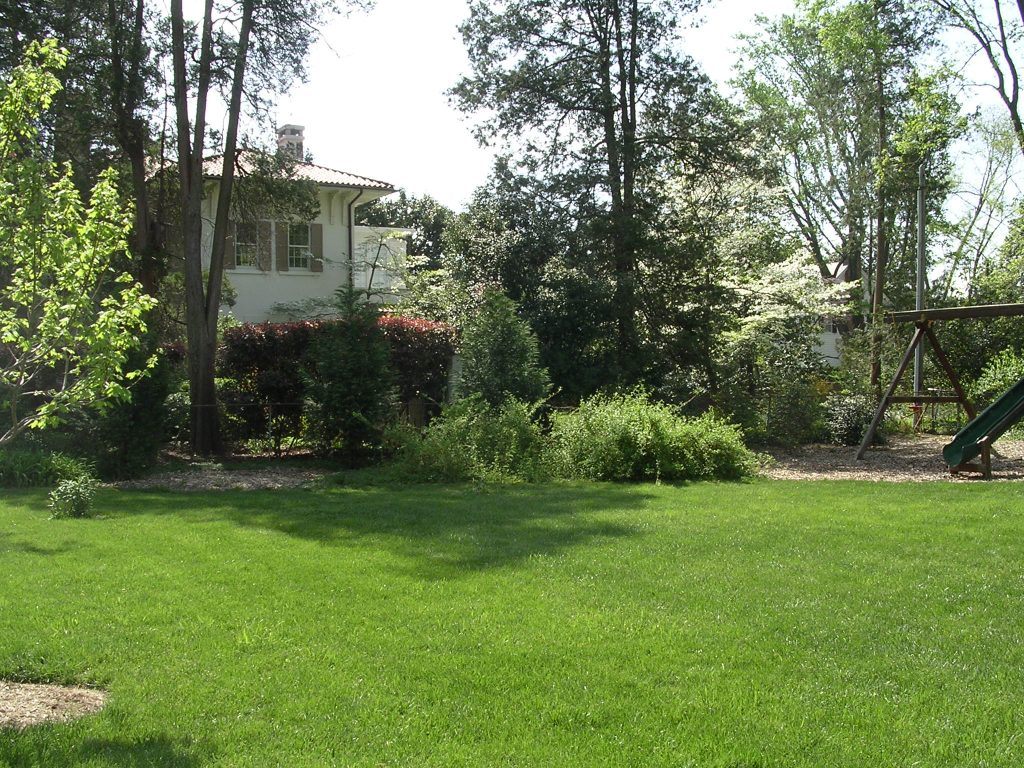
DURING:
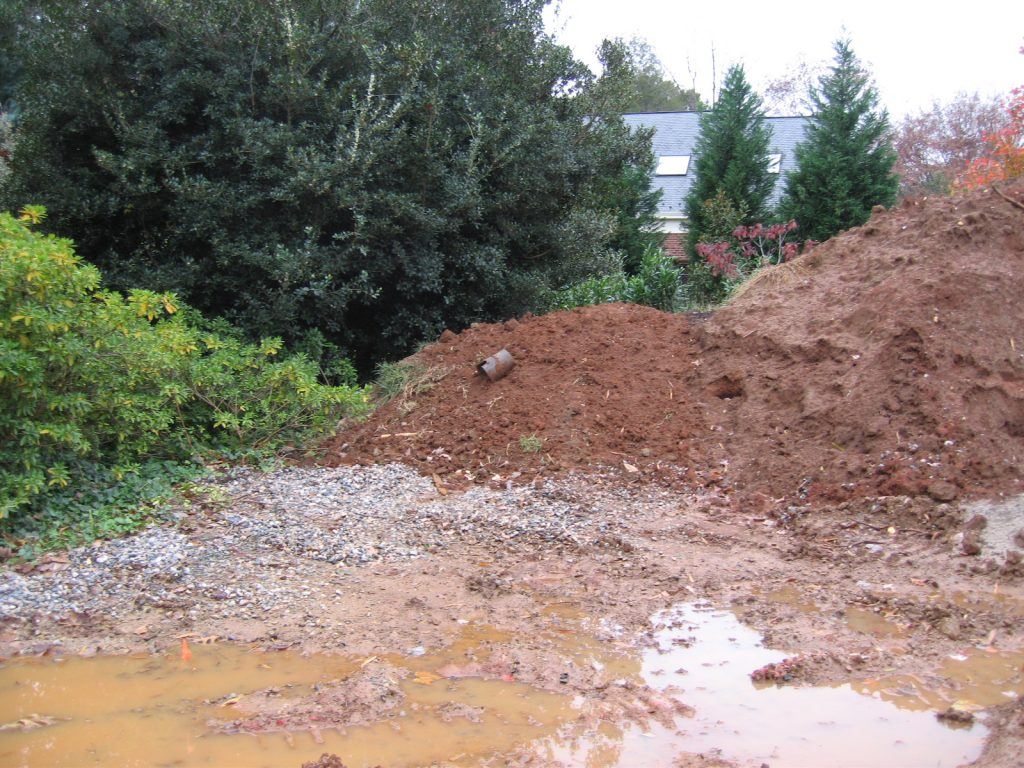
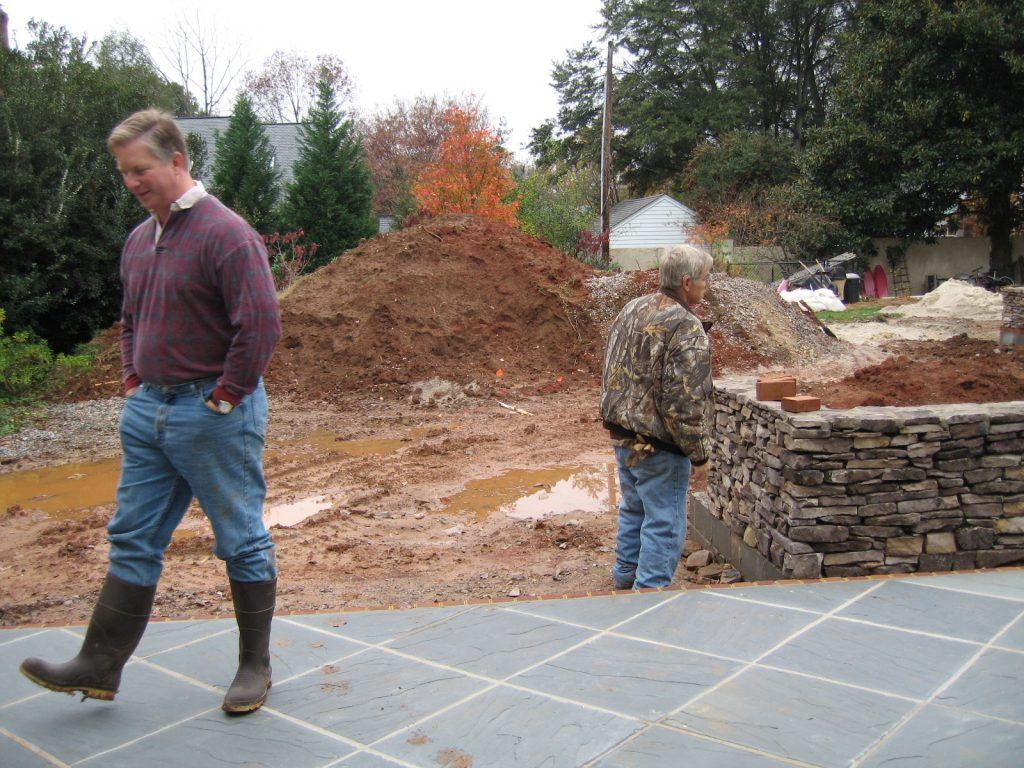
AFTER:
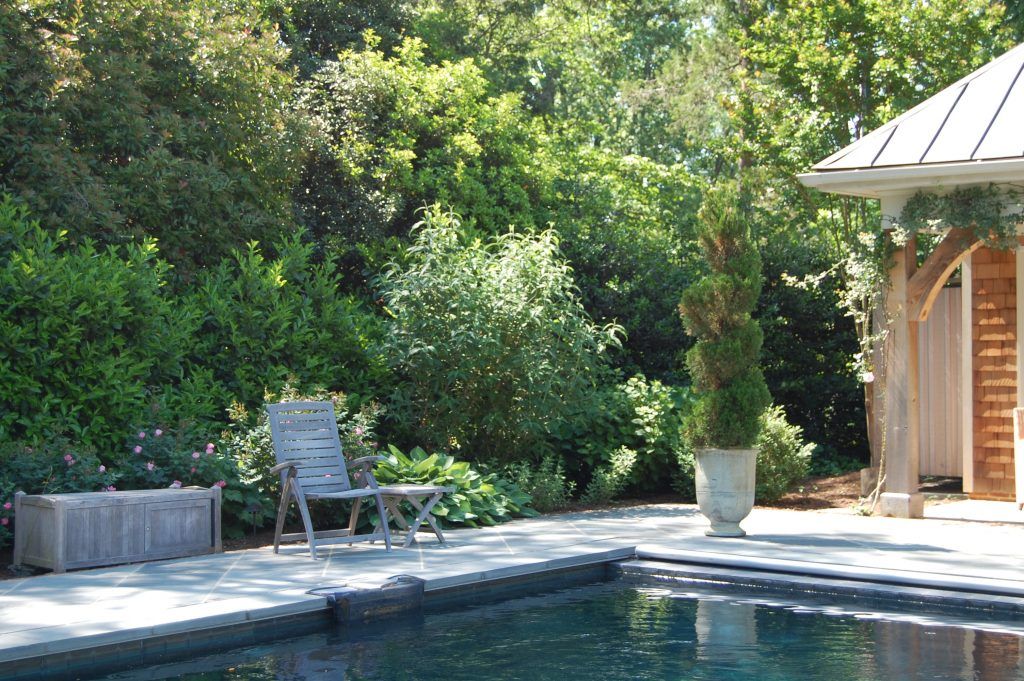
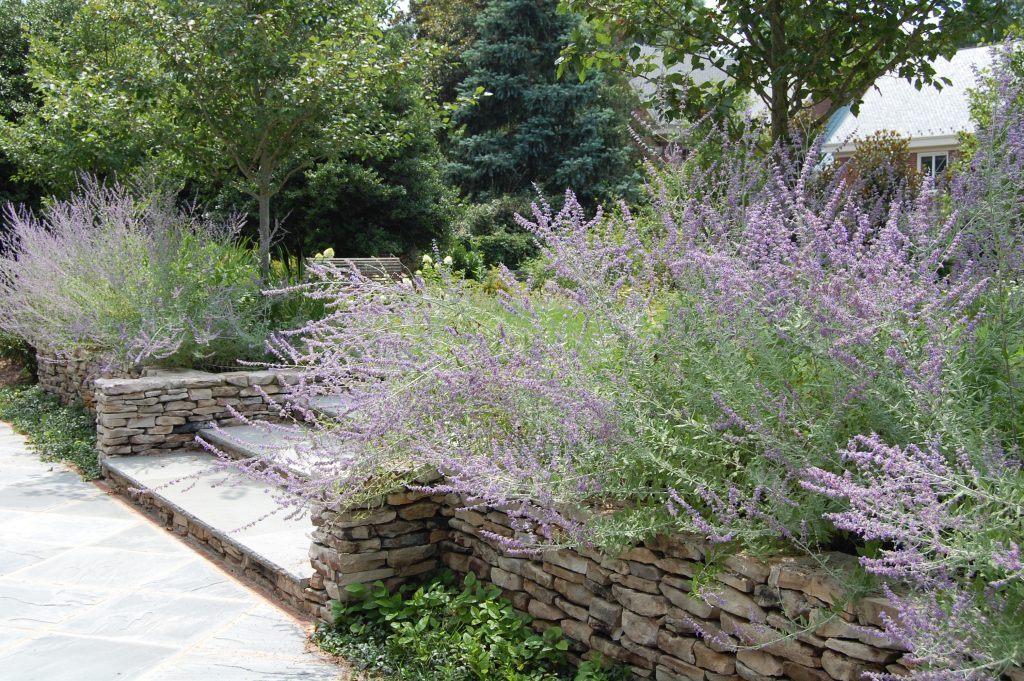
The steps between the pool terrace and the raised garden are wide and expansive, with deep bluestone treads and short stacked-stone risers. Small periwinkle (Vinca minor) softens the hardscape and Russian Sage (Perovskia atriplicifolia ‘Little Spike’) spills over the stacked stone wall.
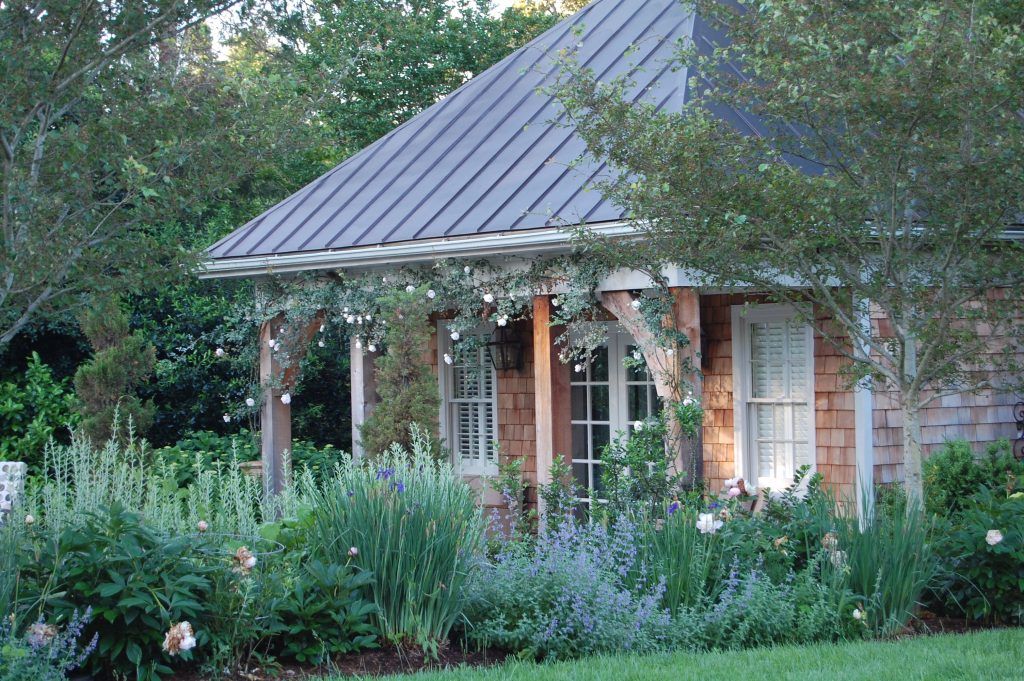
A view toward the pool house from the central garden lawn.
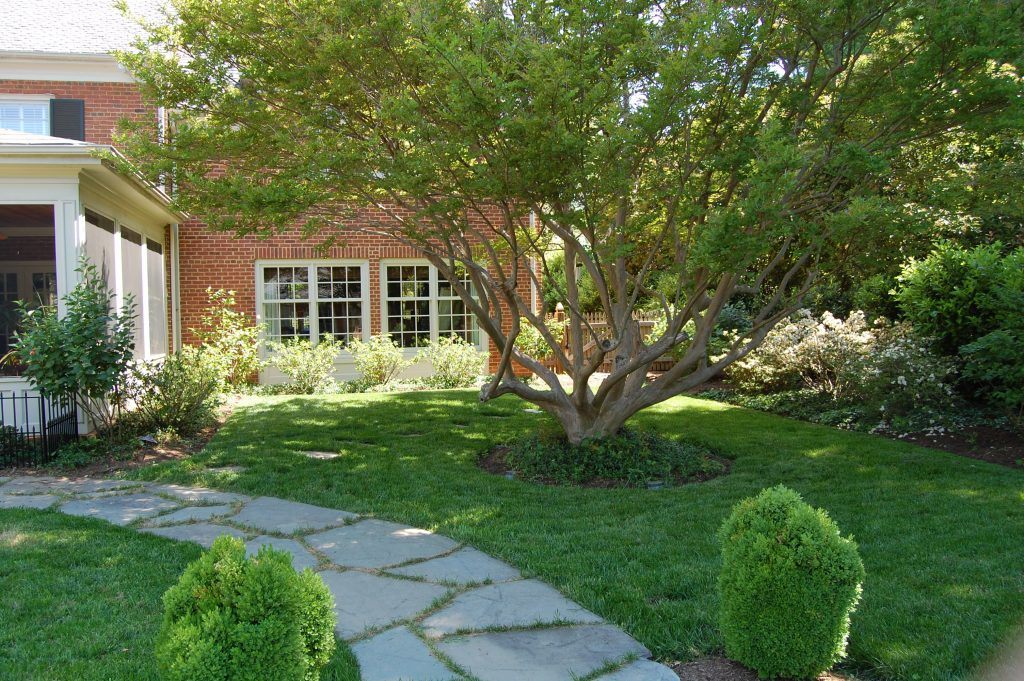
Standing on the pool terrace looking north toward the house. We added a stepping stone path, with grass joints, to lead from the pool to the central courtyard.
The Central Section
The central garden is divided into a lower and an upper garden. The lower garden is a formal courtyard, which acts as the central hub, connecting the pool, the garage, the upper garden, and the arbored terrace.
BEFORE:

The beloved Brewster.
DURING:
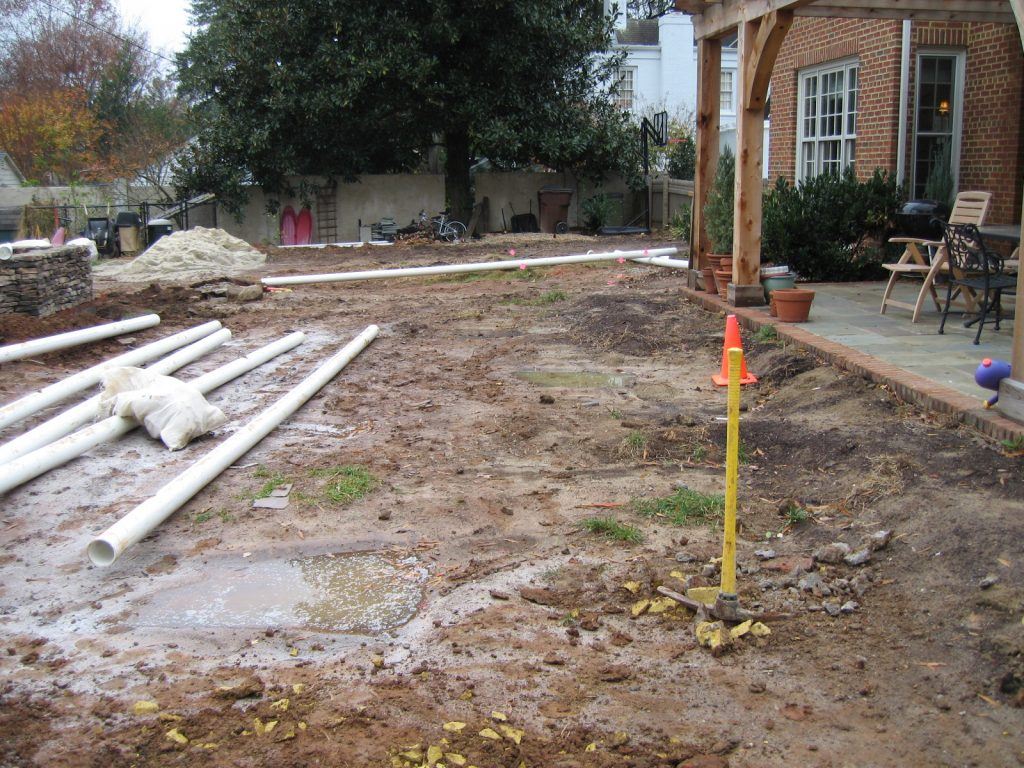
AFTER:
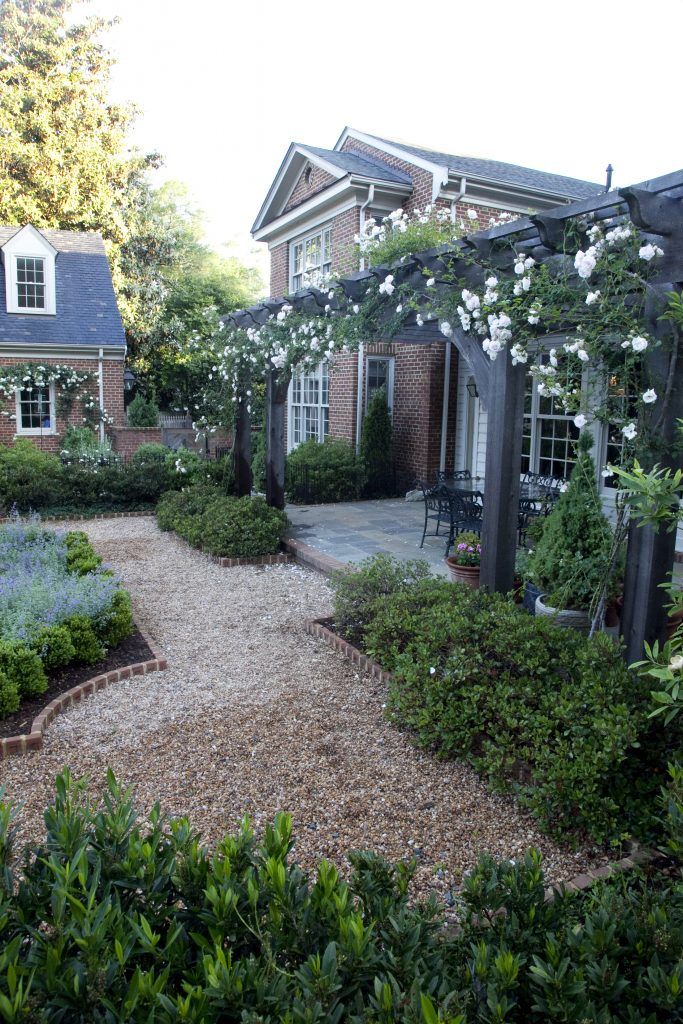 The new brick garage (which replaced the wood shed) and brick wall provide a sense of enclosure for the backyard. The planting beds are edged in brick in what I call a Gillette border.
The new brick garage (which replaced the wood shed) and brick wall provide a sense of enclosure for the backyard. The planting beds are edged in brick in what I call a Gillette border.
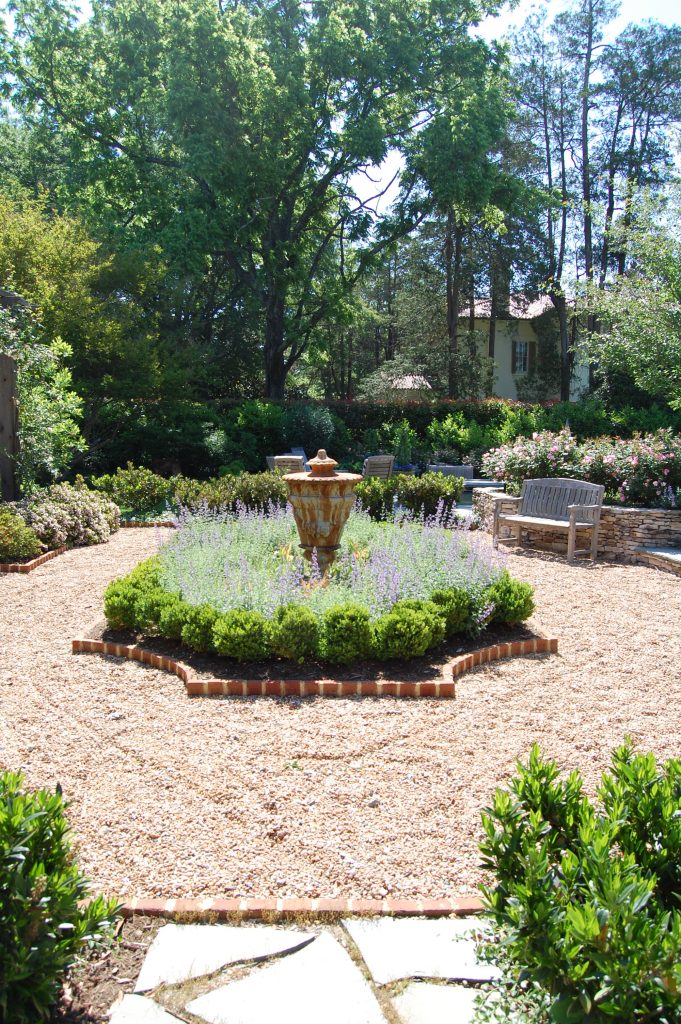
Looking east, toward the pool. The central parterre is edged in Boxwood (Buxus ‘Justin Brouwer’), and filled with tulips in spring and Catmint (Nepeta ‘Walker’s Low’ ) in late spring, summer and fall.
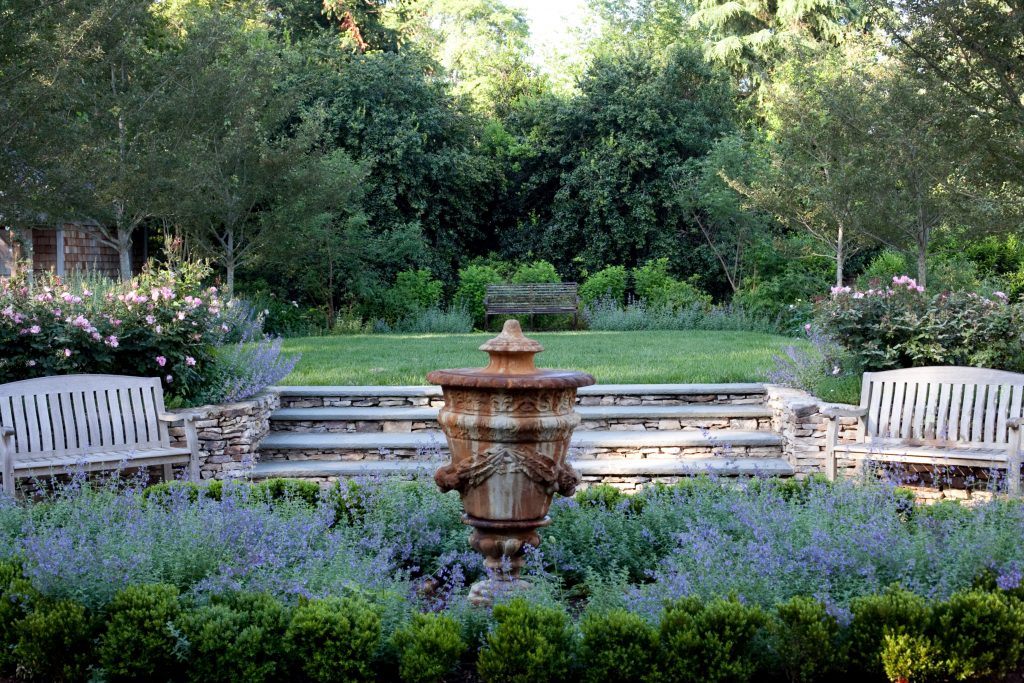
Looking south, toward the upper lawn, above. The stacked stone retaining walls and broad bluestone steps are centered on one sweeping shallow radius. Loretta found the gorgeous urn, perfect in scale and patina, to place on the central axis.
Running with Ben’s idea to use the excavated pool dirt to create elevation, we built stone walls on three sides to create a raised lawn and borders, about three feet above the otherwise very flat grade. Gently arced steps frame the upper garden and lead to the central courtyard. The upper garden’s expansive central lawn is flanked by perennial borders, and punctuated by an allee of Winterking Hawthorn. The Hawthorns’ branches are covered in red berries in fall and winter. Steps lead to the pool to the east, and to the informal garden and garage to the west.
BEFORE:
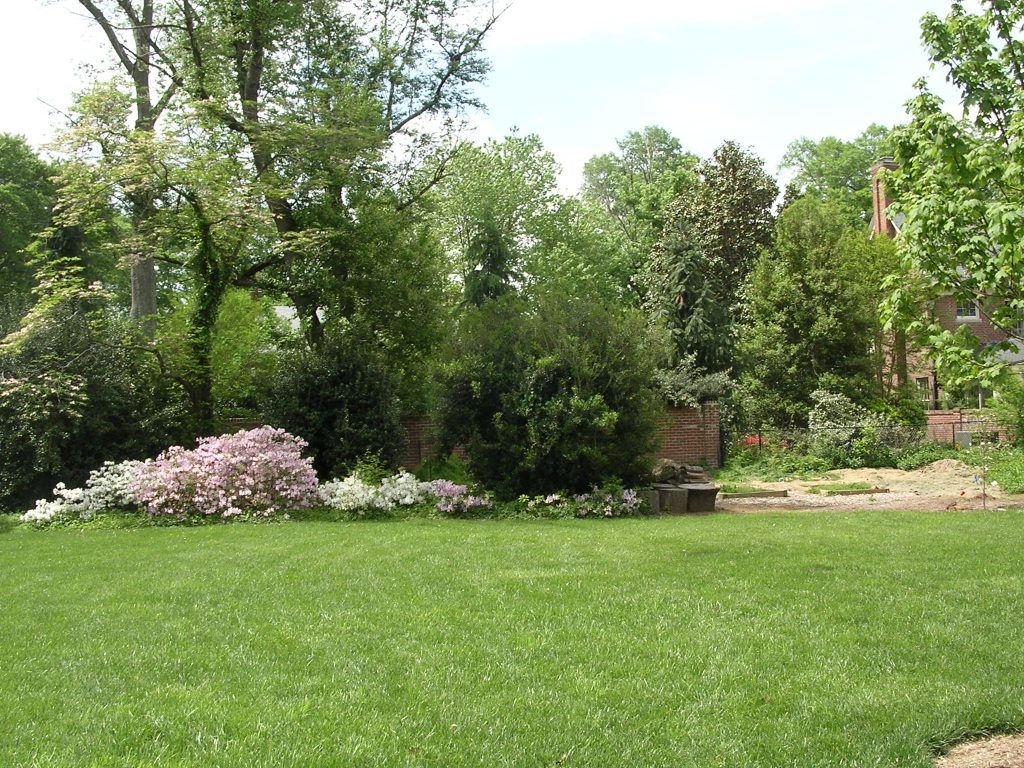
DURING:
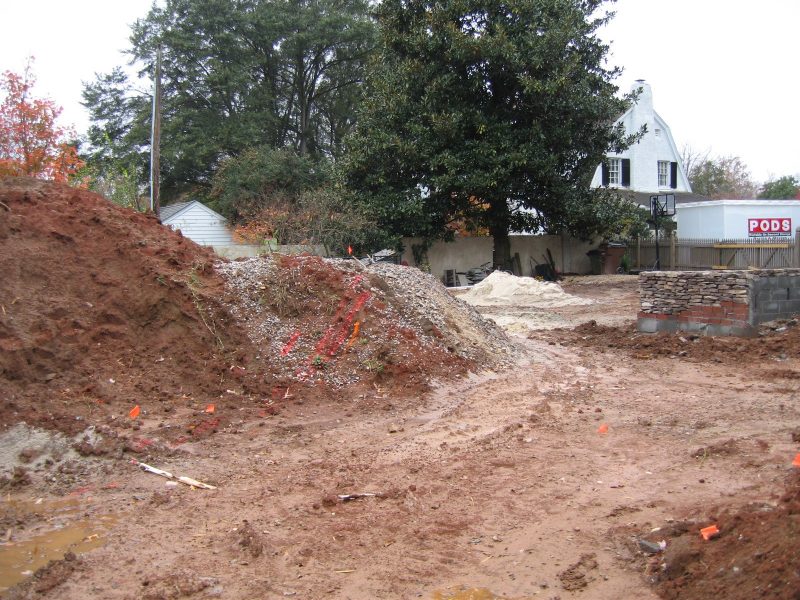

AFTER:
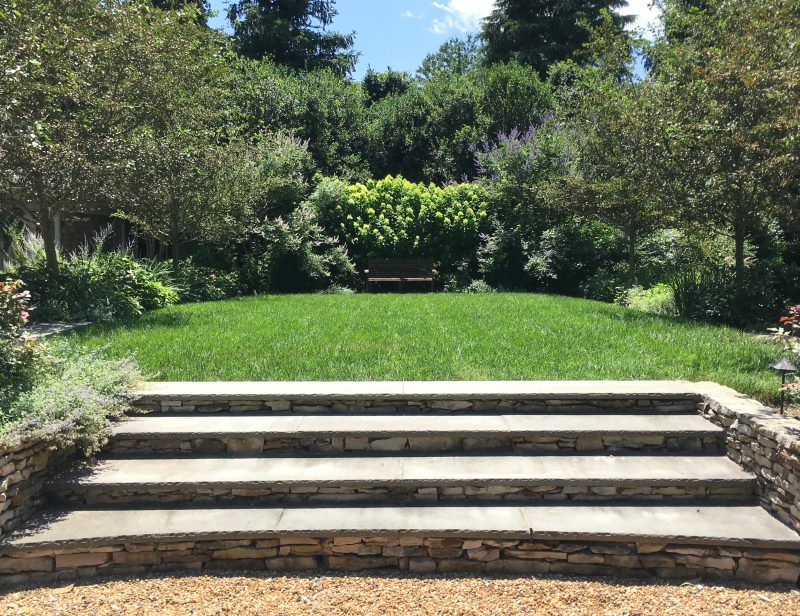
Looking south along the central axis of the garden, toward the terminus bordered by existing American Hollies (Ilex opaca). We added Limelight Hydrangeas (Hydrangea paniculata ‘Limelight’) flanked by Chastetree (Vitex agnus-castus). Loretta found the rustic bench, and we placed it at the south end of the lawn.
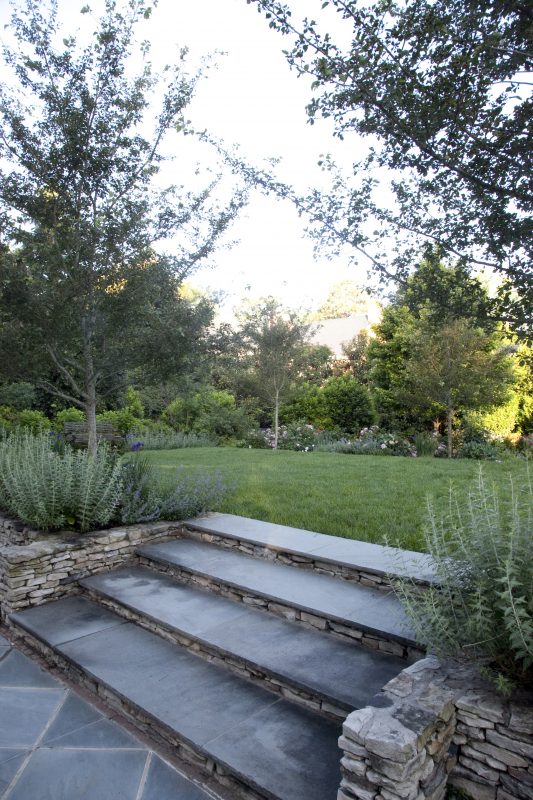
Looking south west, from the pool terrace. Along this same axis are steps that bisect with the tuteur and lead to the more informal west garden and the garage.
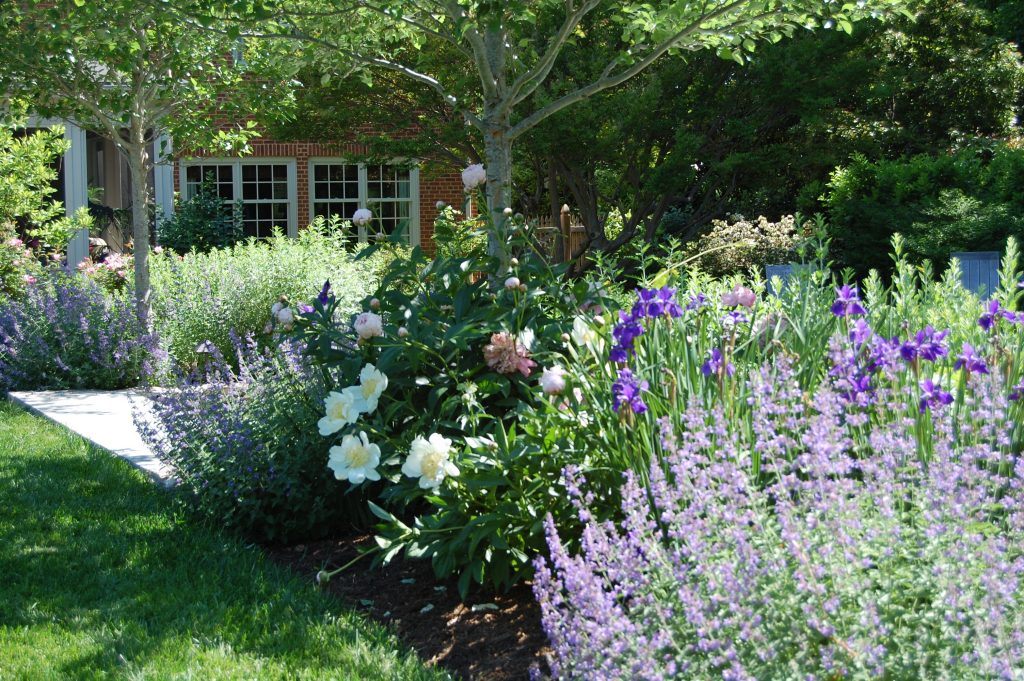
Looking northeast, the perennial border in full bloom with Siberian Iris (Iris siberica ‘Caesar’s Brother’), Catmint (Nepeta x ‘Walker’s Low’), Peonies (Paeonia latifolia), and False Indigo (Baptisia australis).
The West Section
The west section was divided into three spaces. First, the Englishes replaced a small shed with a 2 story garage. We placed an irregular stepping stone path parallel to the garage, where it terminates at a wood tuteur planted with Confederate Jasmine (Trachelospermum jasminoides). To the east of the tuteur are steps that lead to the upper lawn and continue to the pool. To the west is a path to the informal garden, where we filled the planting beds with the plants we dug up during the renovation.
BEFORE:
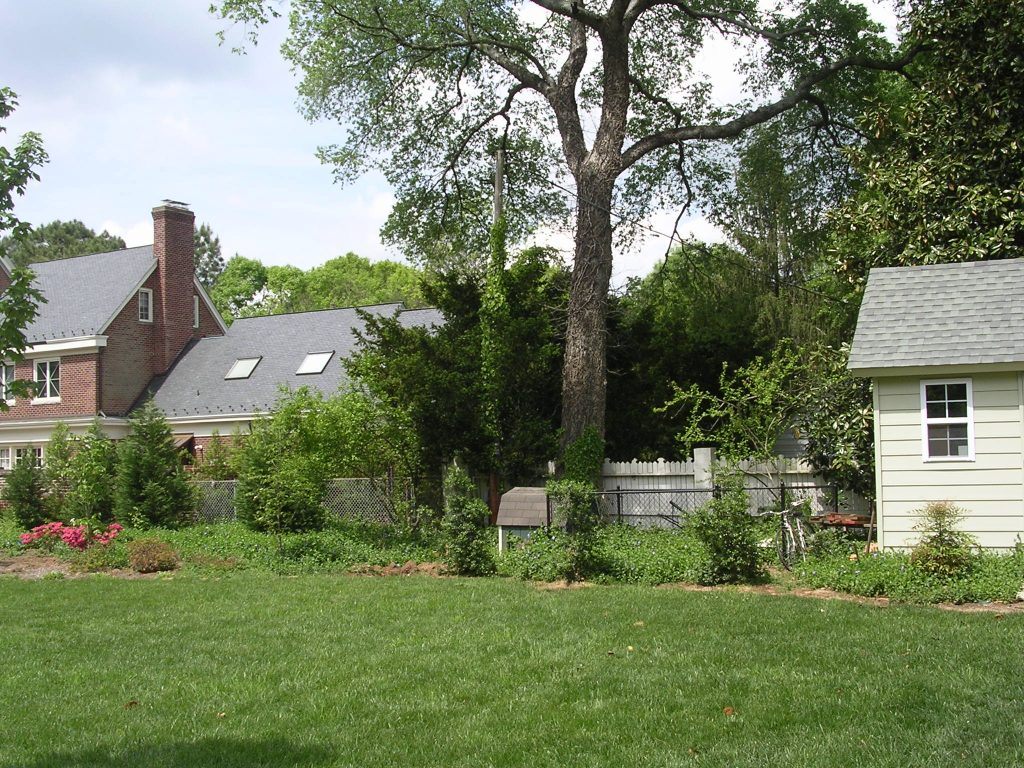
The Englishes had little screen from their neighbors, above, and from the parking area, below, before the renovation.
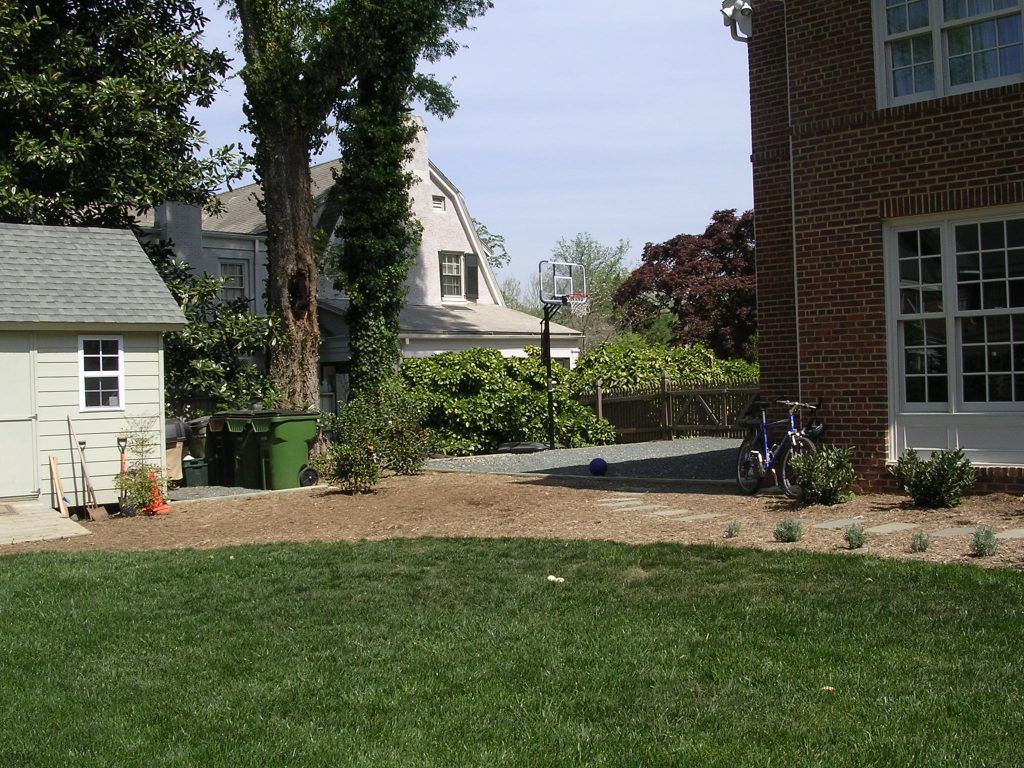
DURING:

AFTER:
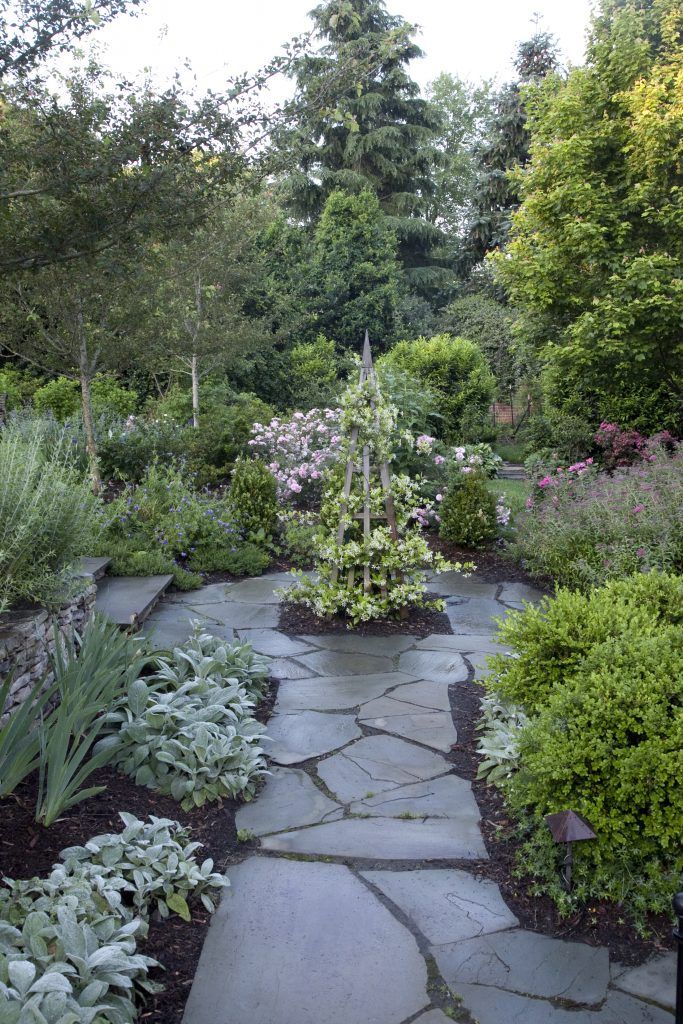
The stepping stone path leads to the nexus of the entrances to the central upper garden on the left, and the informal garden, on the right, which can be seen in the background.
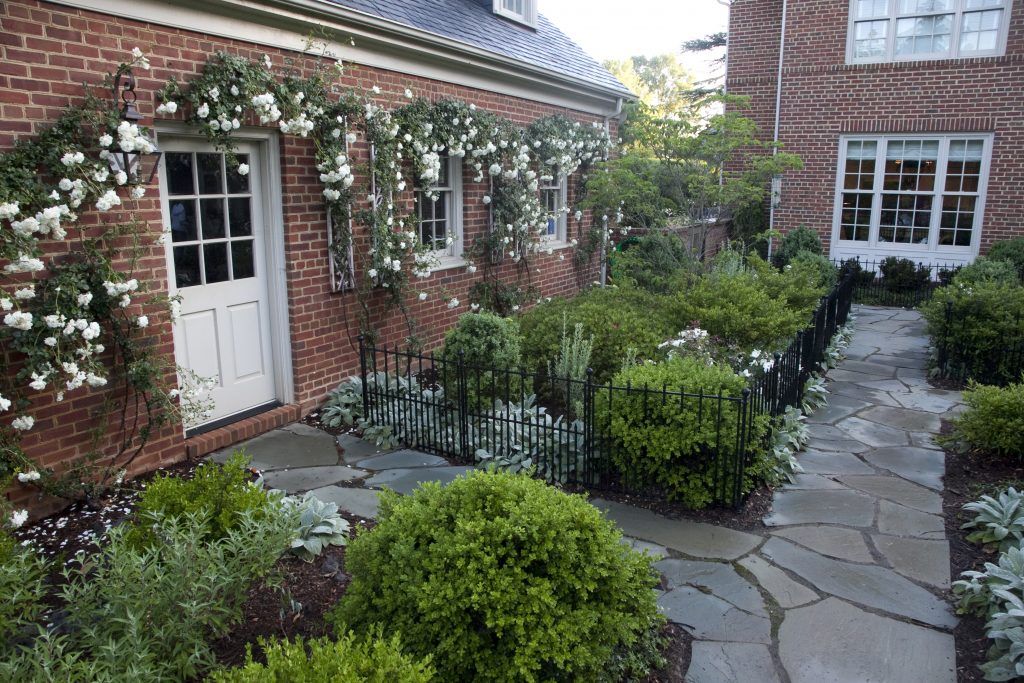
The iron grillwork that Loretta found at Caravati’s softens the brick facade of the garage. White Dawn climbing rose are supported by the ironwork. The silver foliage of Lamb’s Ears (Stachys byzantina ‘Silver Carpet’) and Bearded Iris (Iris germanica) play off the cool colors of the stone. Ben installed “temporary” fencing to protect the garden from their puppy’s shenanigans.
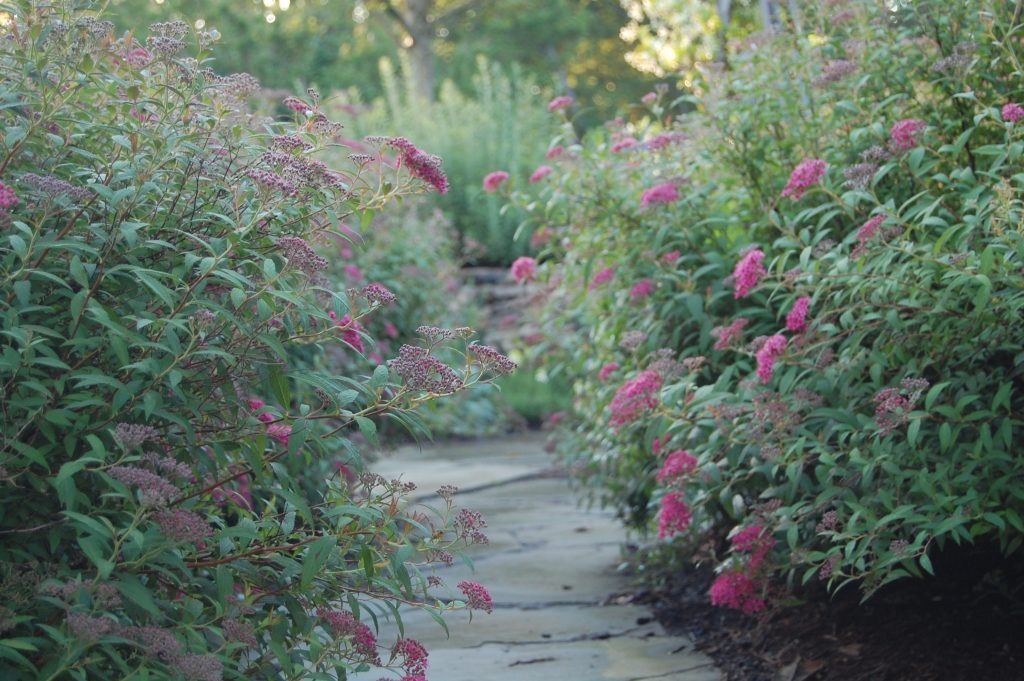
Spirea (Spiraea japonica ‘Anthony Waterer’) spills over the path from the tuteur to the informal garden.
The Englishes have generously shared their renovated garden with many, hosting their kids’ teammates and friends and opening for garden tours benefitting the community. Their vision and beautiful taste shaped the garden, and our collaboration with the talented and hard-working masons, carpenters, general contractors and, most especially, the late great landscaper William Lowe, ensured that the plans were faithfully and skillfully executed, resulting in a well-loved garden.
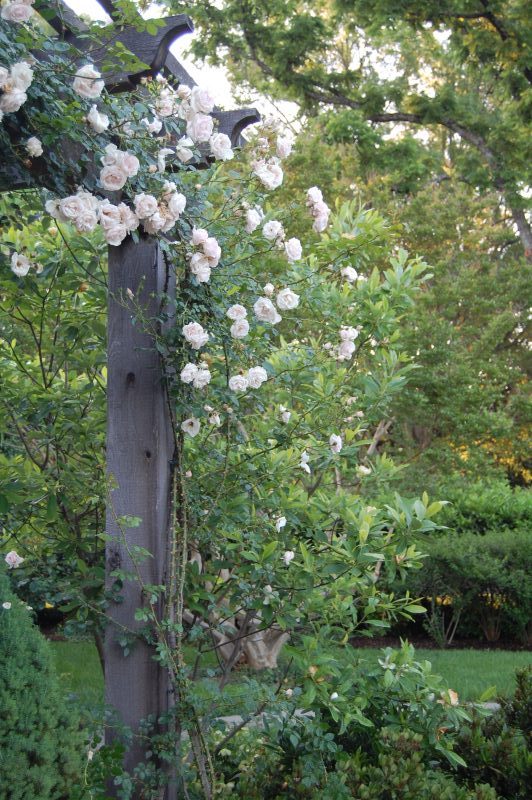
Many of the AFTER photographs (the good ones — you can tell the difference!) used in this blog were taken by the uber-talented Helen Horsley.
HISTORIC GARDEN WEEK 2016: THE ARRANGEMENTS
Another year, another stellar collection of flower arrangements by talented members of the James River Garden Club for Historic Garden Week. The women, as always, used mostly greens and flowers from their own gardens.
The team of Noni Baruch, Mary Frediani, Elizabeth Hickey, Sheila MacFarlane, Betsy Trow and Sarah Wiley took their inspiration from the beautiful 1798 farmhouse of Louise and Russell Bowles, which was on the Friday Richmond tour.
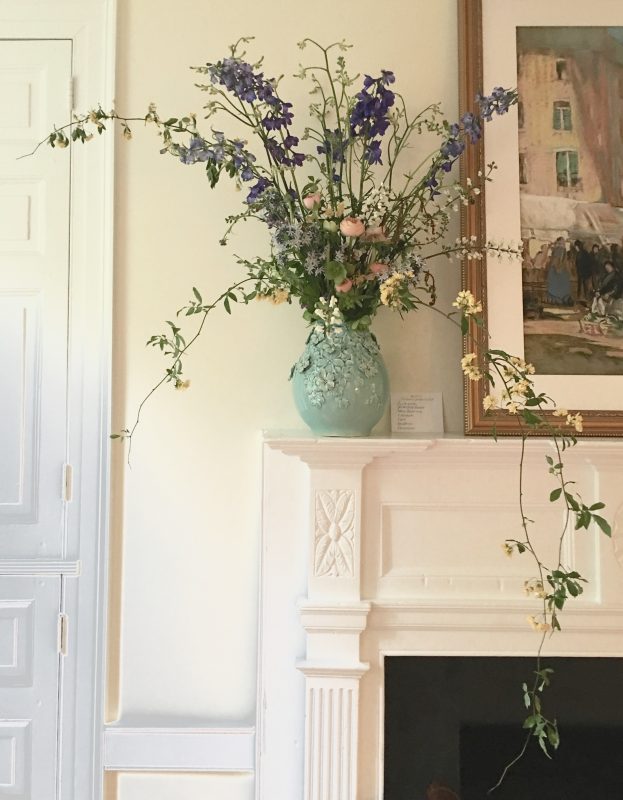
Lady Banks Rose (Rosa banksiae), White False Indigo (Baptisia pendula), Larkspur (Delphinium, spp.), Ranunculus (Ranunculus, spp.), Blue Star (Amsonia tabernaemontana), Lenten Rose (Helleborus orientalis), Fern fiddlers.
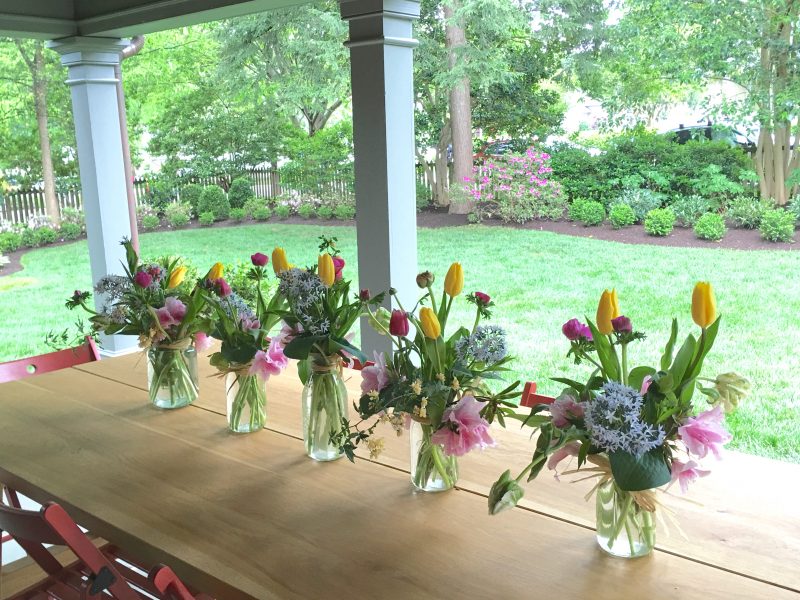
Tulip, Azalea, Blue Star, Lenten Rose, Lady Banks Rose, Anemone
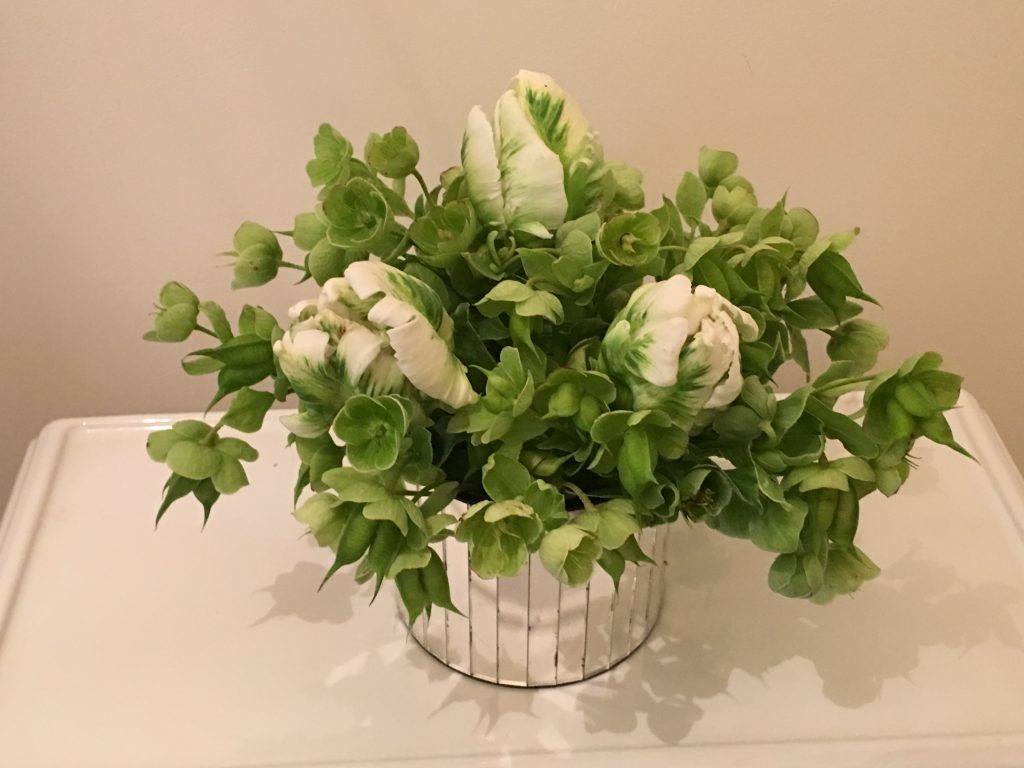
Stinking Hellebore (Helleborus foetidus) (a very unfair common name! — I think it smells like pepper) and Parrot Tulip
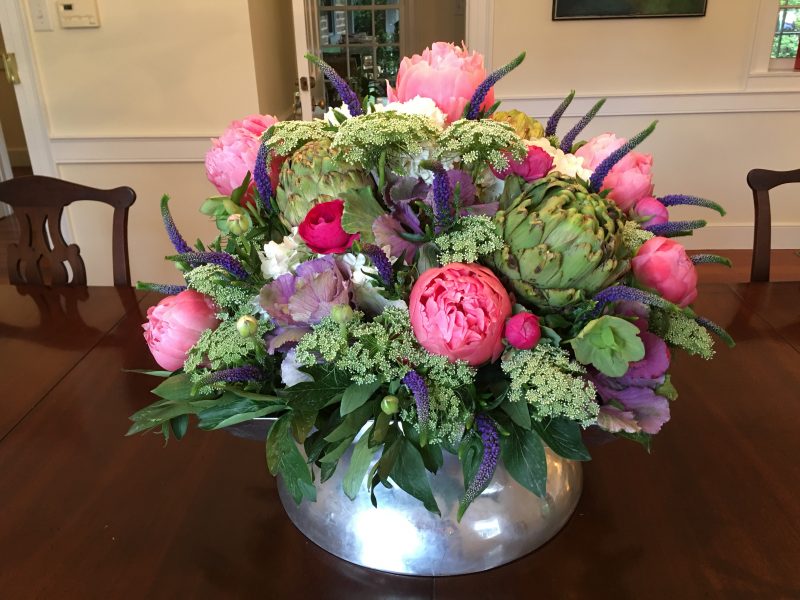
Peony (Paeonia, spp.), Snowball Viburnum (Viburnum opulus ‘Sterile’), Queen Anne’s Lace (Daucus carota), Speedwell (a guess — Veronica spicata?), Rose, Lenten Rose, Artichoke (Cynara cardunculus var. scolymus) and Purple Kale (Brassica oleracea)
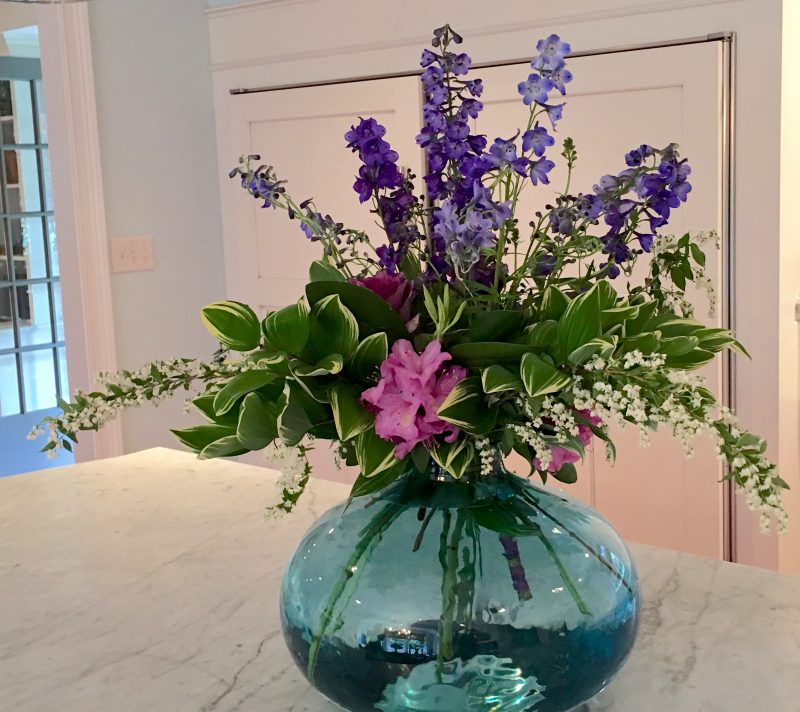
Rhododendron (Rhododendron x PJM), Slender Deutzia (Deutzia gracilis), Variegated Solomon’s Seal (Polygonatum odoratum ‘variegatum’), Larkspur
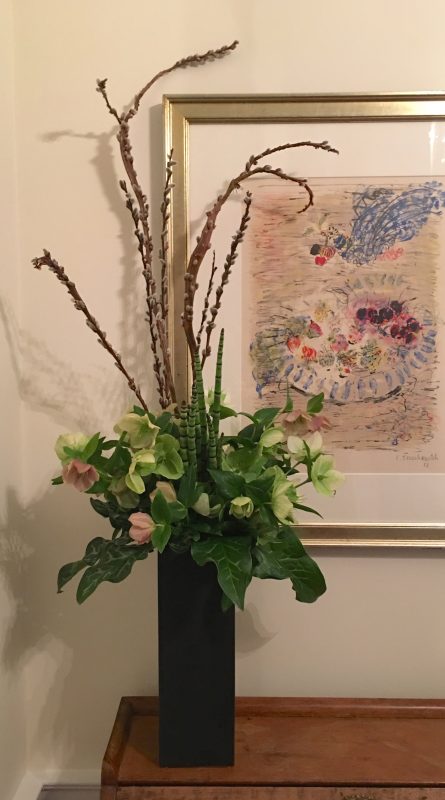
Horse Tail Palm, Pussy Willow (Salix discolor), Arum (Arum italica), Lenten Rose
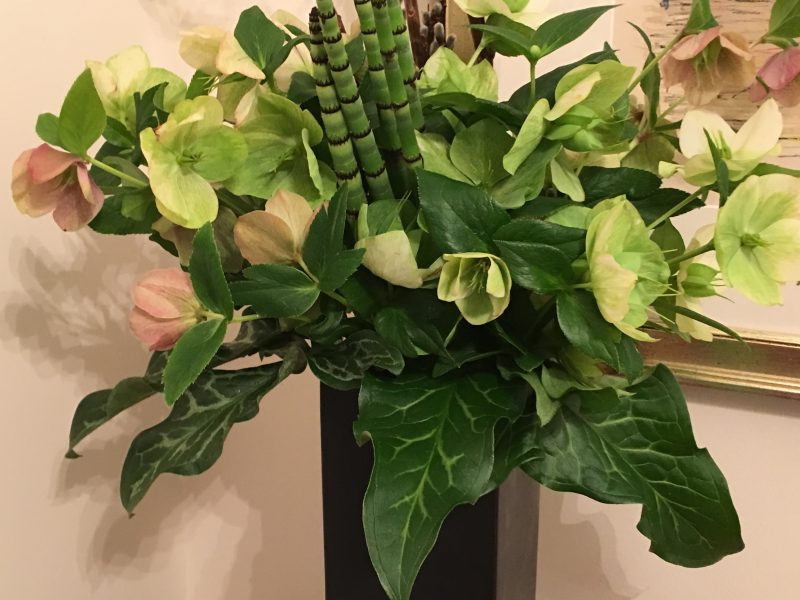
A close up of the Lenten Rose and Arum
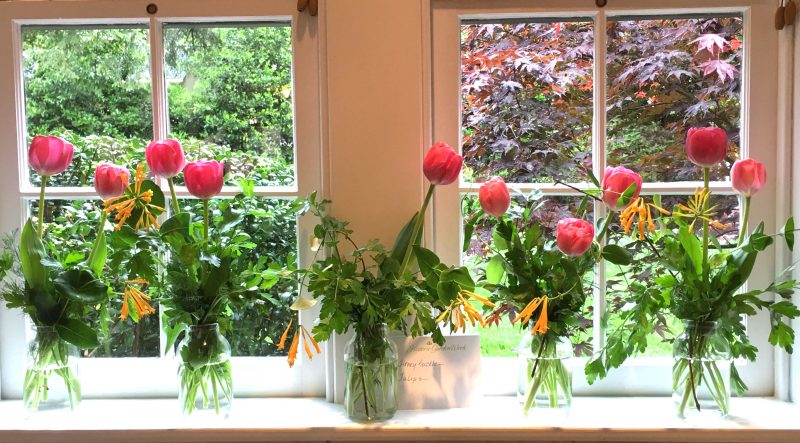
Tulip, Honeysuckle (Lonicera sempervirens — possibly the cultivar Sulpherea?)
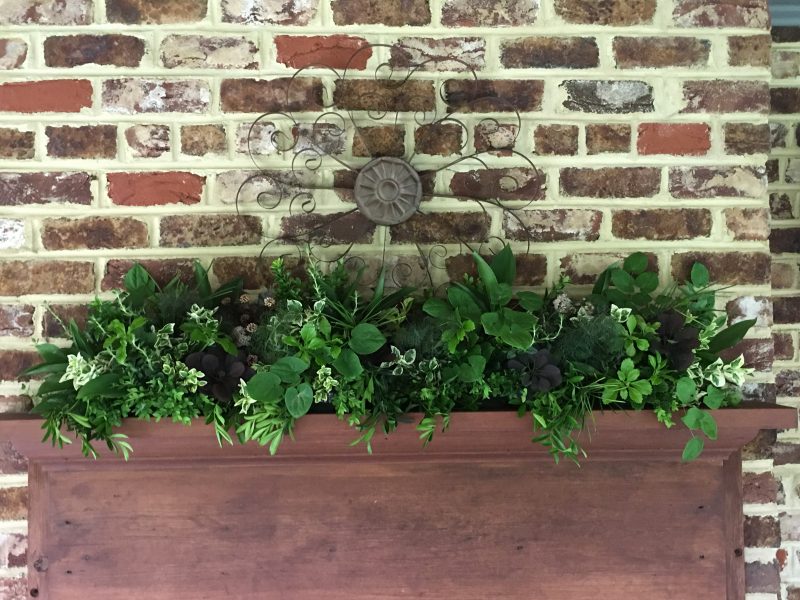
Smokebush (Cotinus coggygria) (really stands out with the brick), Barrenwort (or Bishop’s Hat) (Epimedium grandiflorum), Variegated Wintercreeper (Euonymus fortunei), Boxwood (Buxus, spp.), Pine (Pinus, spp.), Lily of Valley (Convallaria majalis), Pachysandra (Pachysandra terminalis), and is that Hawthorn and Fennel tucked in there?

A close up of this magnificent arrangement
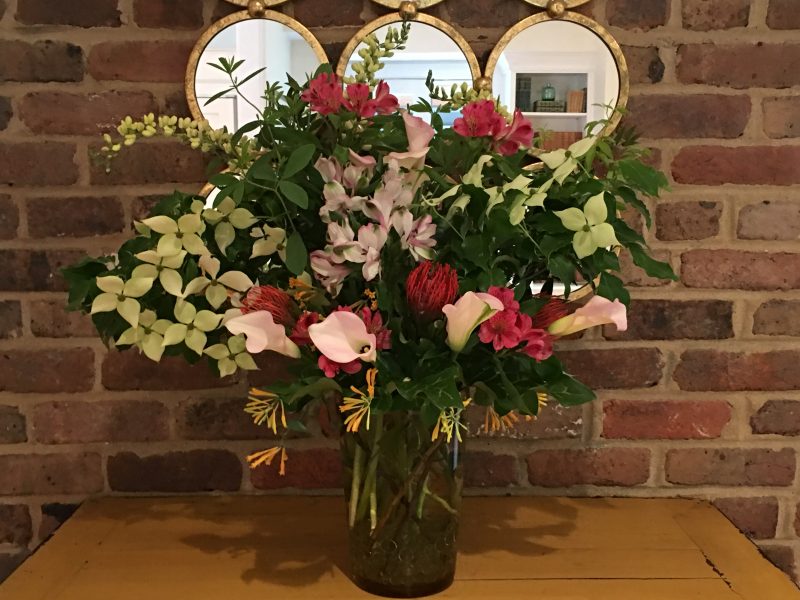
Kousa Dogwood (Cornus kousa), Pink Dogwood (Cornus florida ‘Rubra Pink’), Honeysuckle, Protea, Calla Lily (Zantedeschia aethiopica), Alstroemeria, Arum
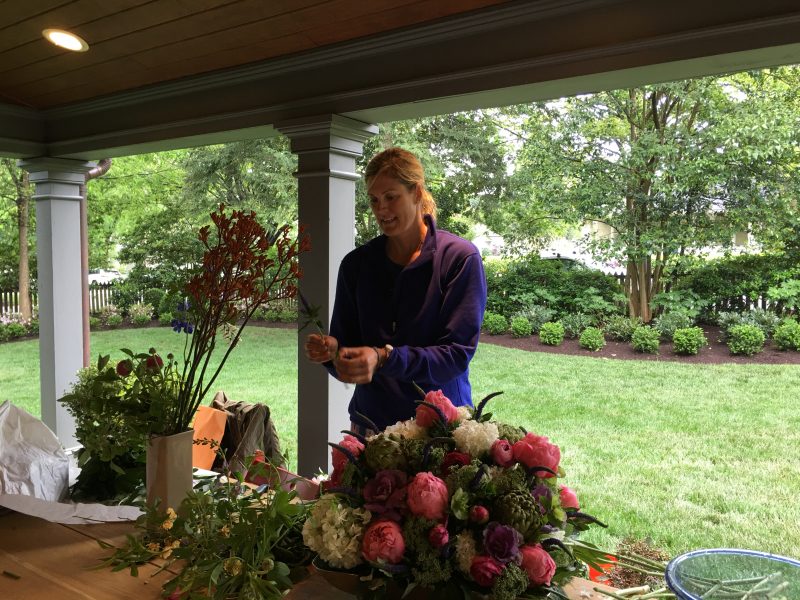
Elizabeth Hickey at work.
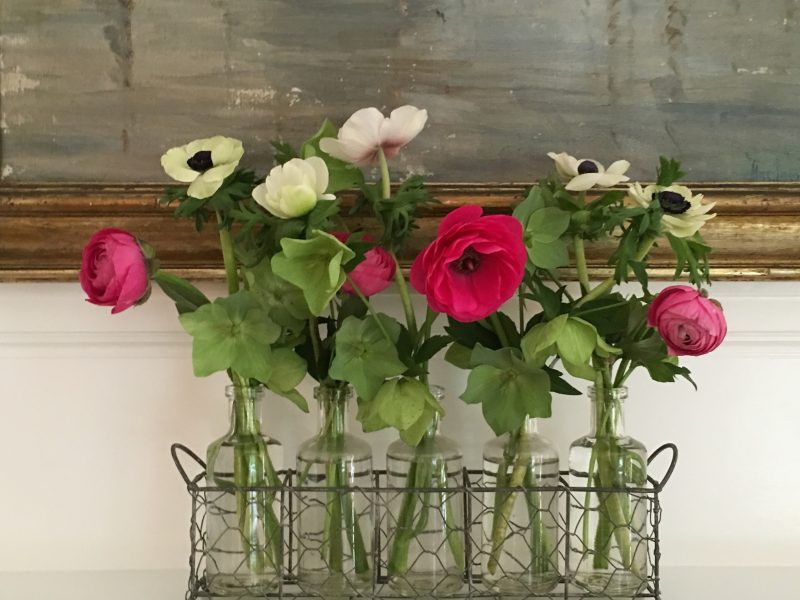
Ranunculus, Anemone and Lenten Rose
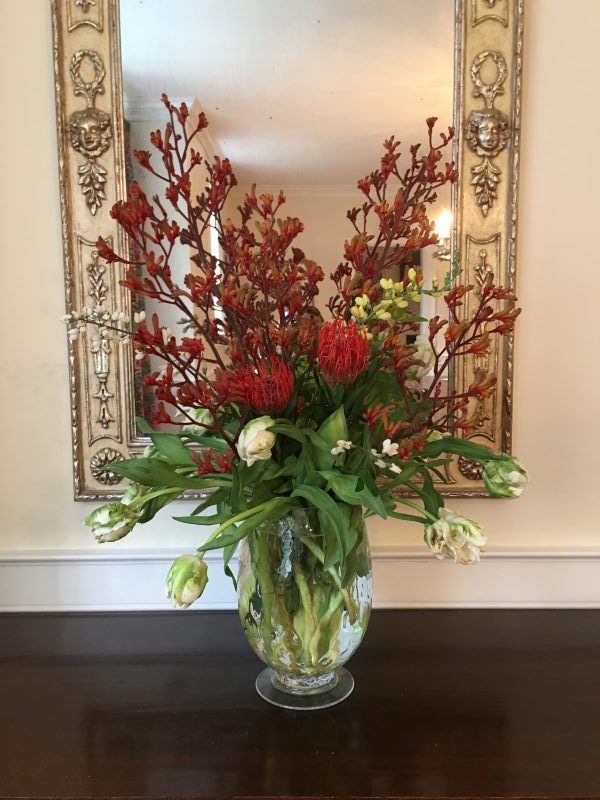
Tulip, Protea, White False Indigo and Kangaroo Paw (Anigozanthus genus?)
At Westover Plantation, homeowner Andrea Erda and her mother Muschi Fisher did the arrangements,
using only plants grown in Westover’s gardens.
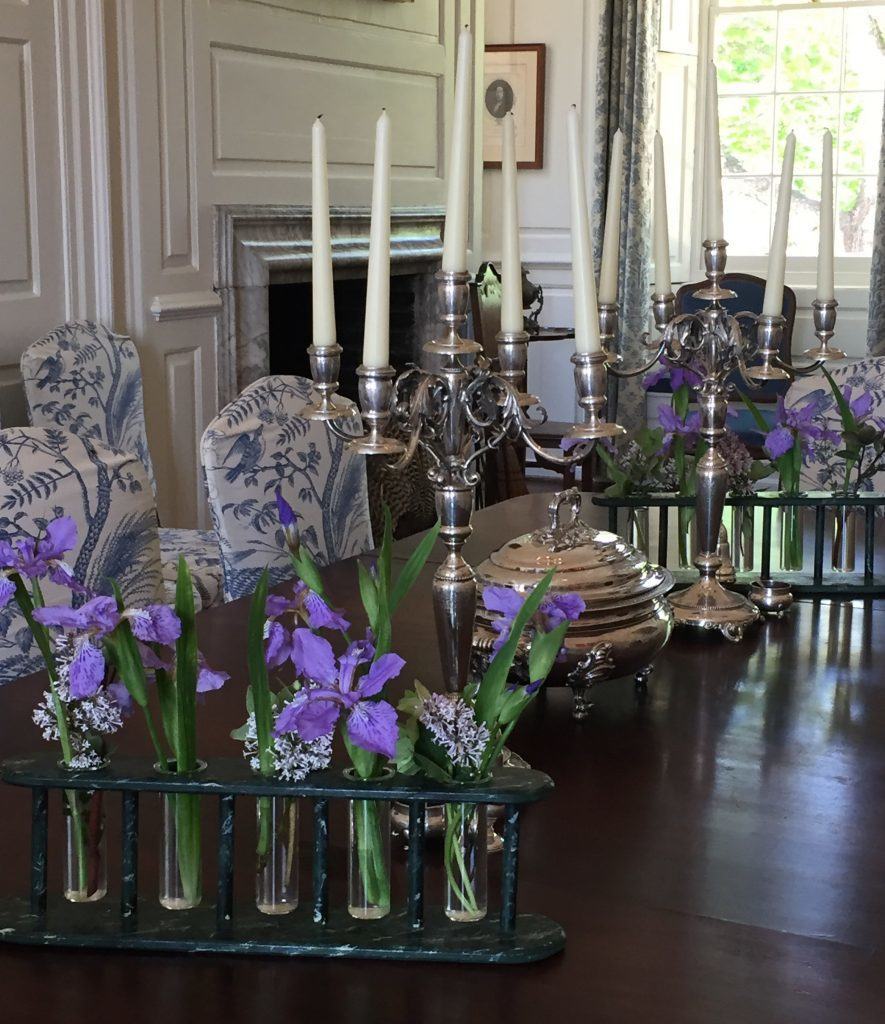
Iris (not sure which — ensata? cristata?) and, perhaps Lilac (Syringa vulgaris)?
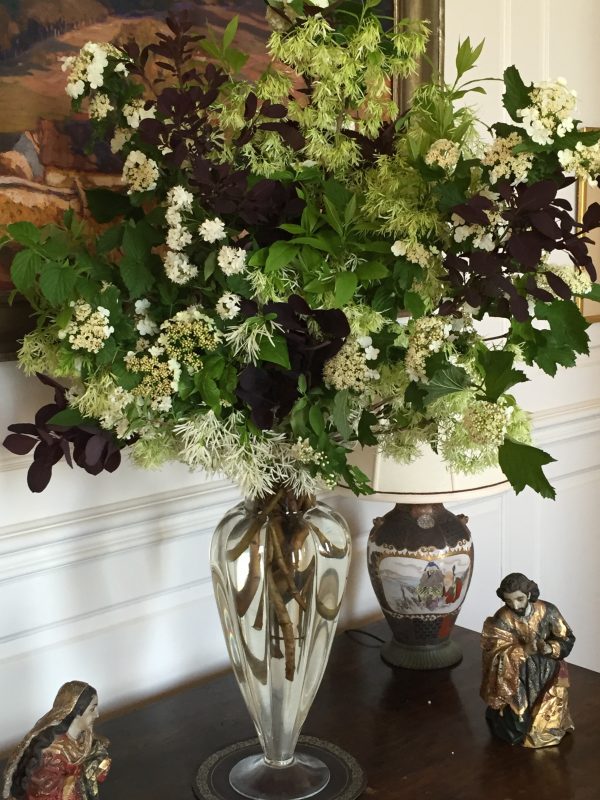
Smokebush (the dark foliage), Virginia Fringetree (Chionanthus virginicus), Viburnum — not sure which species, maybe American Cranberrybush Viburnum? (Viburnum trillium), and Spirea
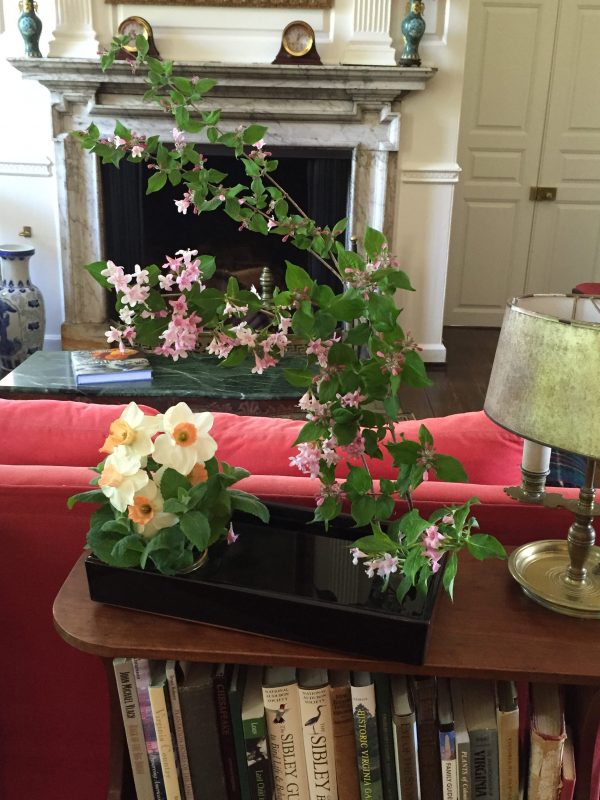
Daffodil (Narcissus, spp.) and Beautybush (Kolkwitzia amabilis)
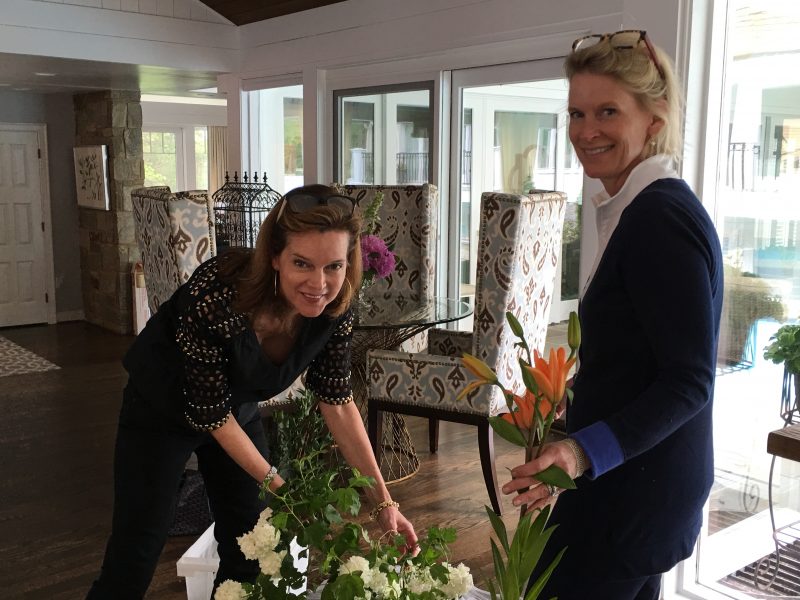
Margaret Reynolds, Susie Rawles (both pictured above), Tenley Beazley, Deborah Valentine and Gaylen Reynolds provided gorgeous arrangements for Pamela and Clark McGhee’s light-filled home crafted of stone, glass and redwood.
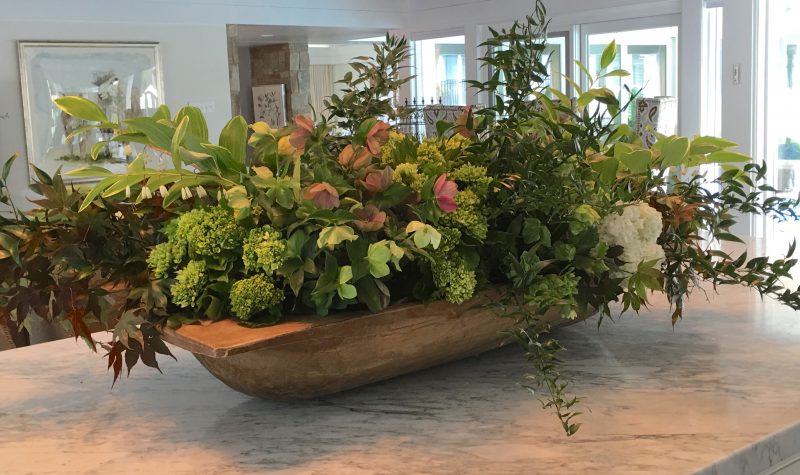
Japanese Maple (Acer palmatum), Poet’s Laurel (Danae racemosa), Hydrangea (Hydrangea macrophylla), Lenten Rose, Variegated Solomon’s Seal, Snowball Viburnum
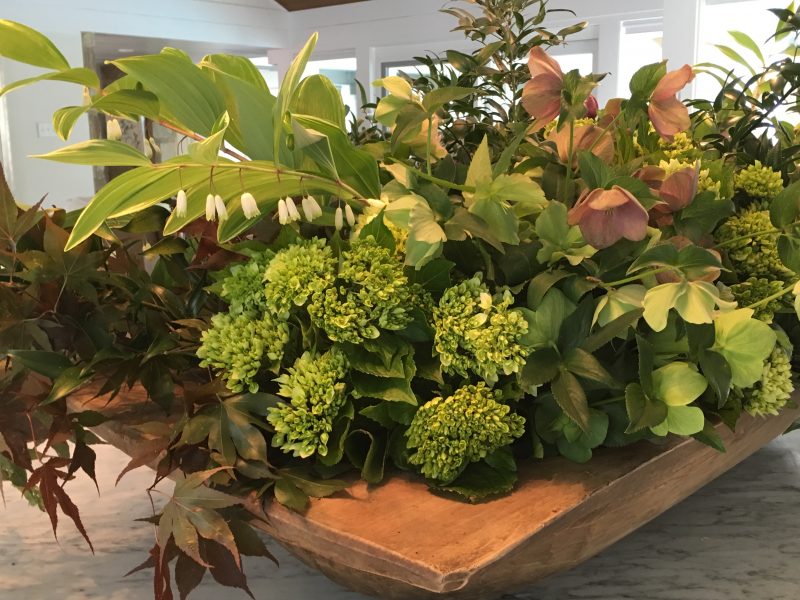
A close up reveals how the subtle neutral palette is enhanced by the washed out reds of the Japanese Maple and the Lenten Rose.
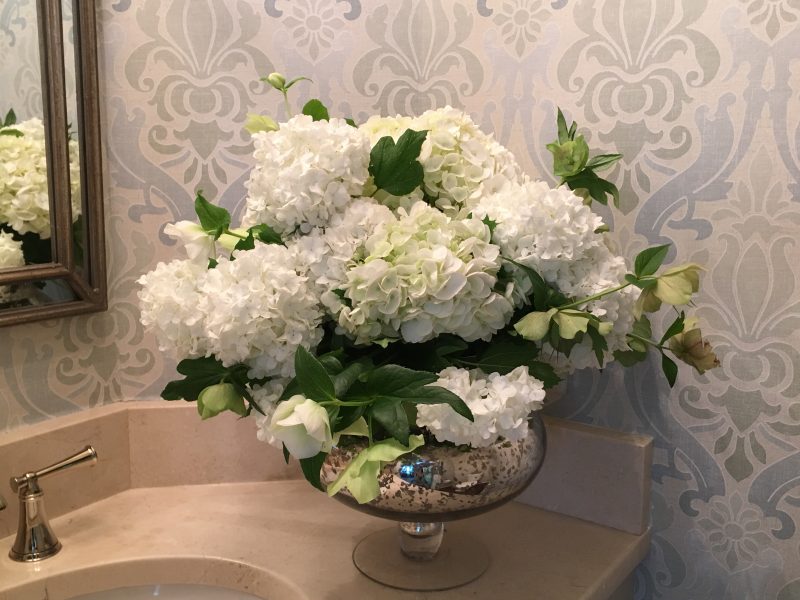
Hydrangea, Snowball Viburnum and Lenten Rose
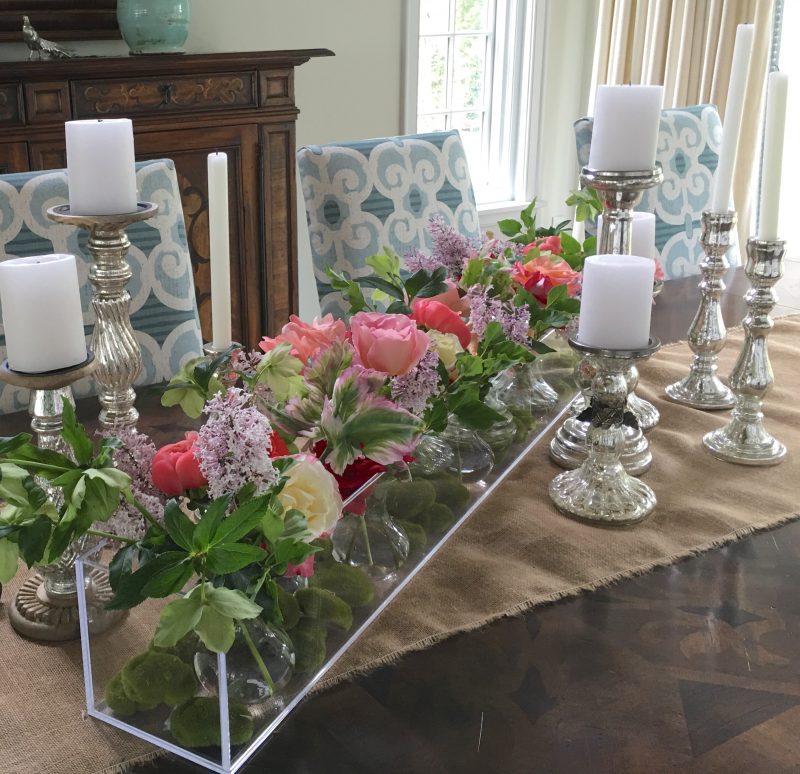
Garden Rose, Parrot Tulip, Lilac and Lenten Rose, with moss covered rocks at the base
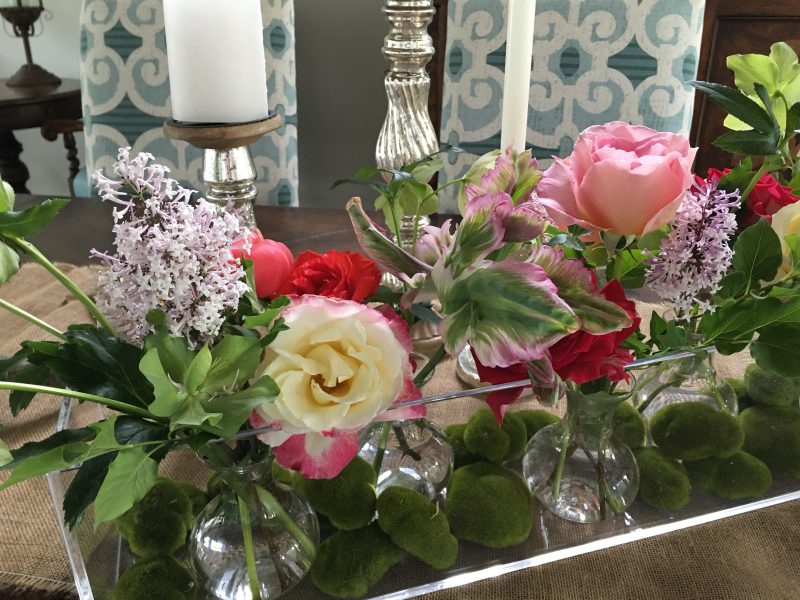
The roses and lilacs used in this spectacular linear arrangement are from JRGC member Betsy Hamilton’s garden.
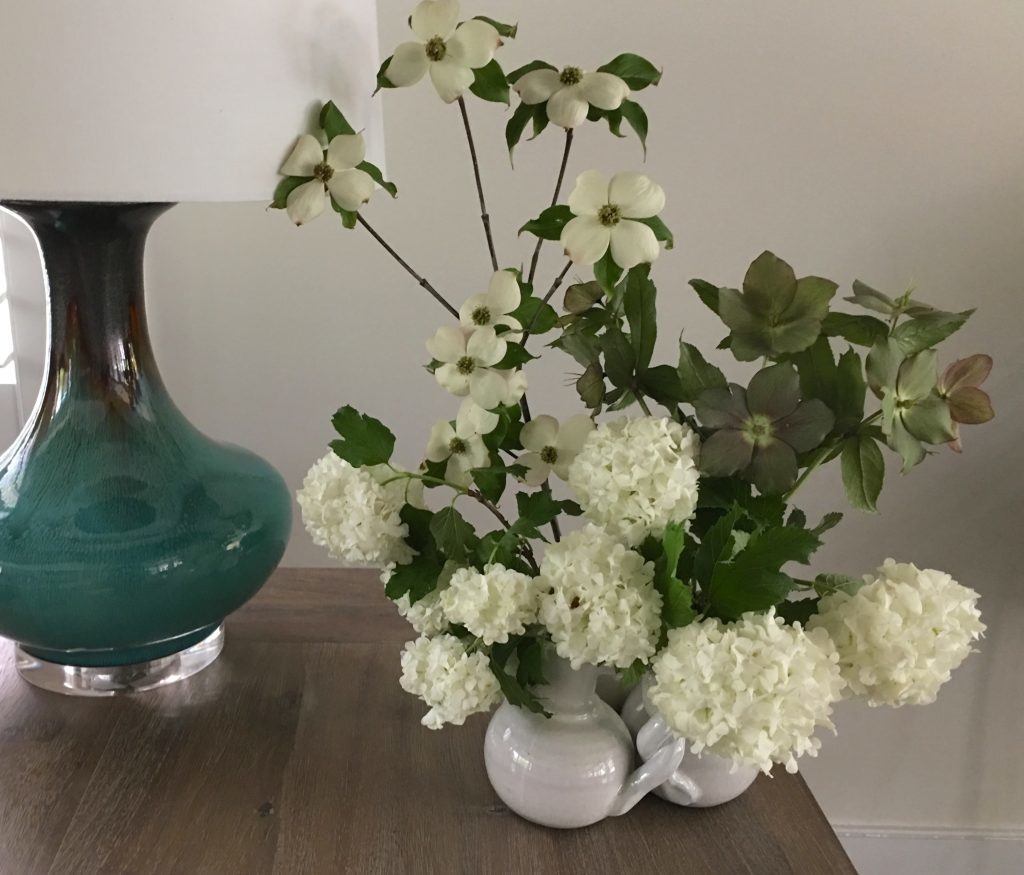
Snowball Viburnum, Flowering Dogwood and Lenten Rose
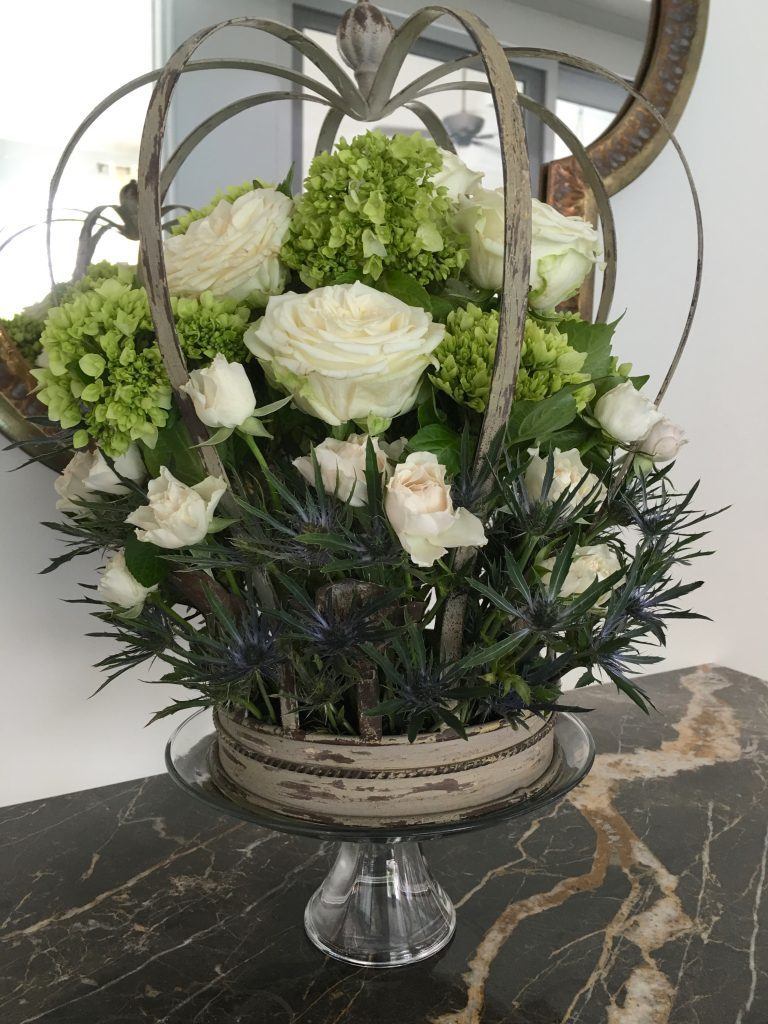
Rose, Hydrangea and Sea Holly (Eryngium amethystinum).
To see more beautiful arrangements and other excellent coverage of Historic Garden Week, visit The Gracious Posse blog.
[custom-related-posts title=”Related Posts” none_text=”None found” order_by=”title” order=”ASC”]
HISTORIC GARDEN WEEK 2016: RIVERVIEW FARM ALONG THE JAMES RIVER
A tip of the hat to Susan Robertson, who texted me yesterday afternoon to tell me to jump in my car and drive out to see Riverview Farm, on tour for the Garden Club of Virginia’s Historic Garden Week. At that moment, I was struggling with writing another Garden Week post, and it just wasn’t working. Happy for a diversion, I texted back, “yes ma’am” and took off. This post is a much too superficial and quick post about a fascinating, inspiring, beautiful and significant working farm along the James River.
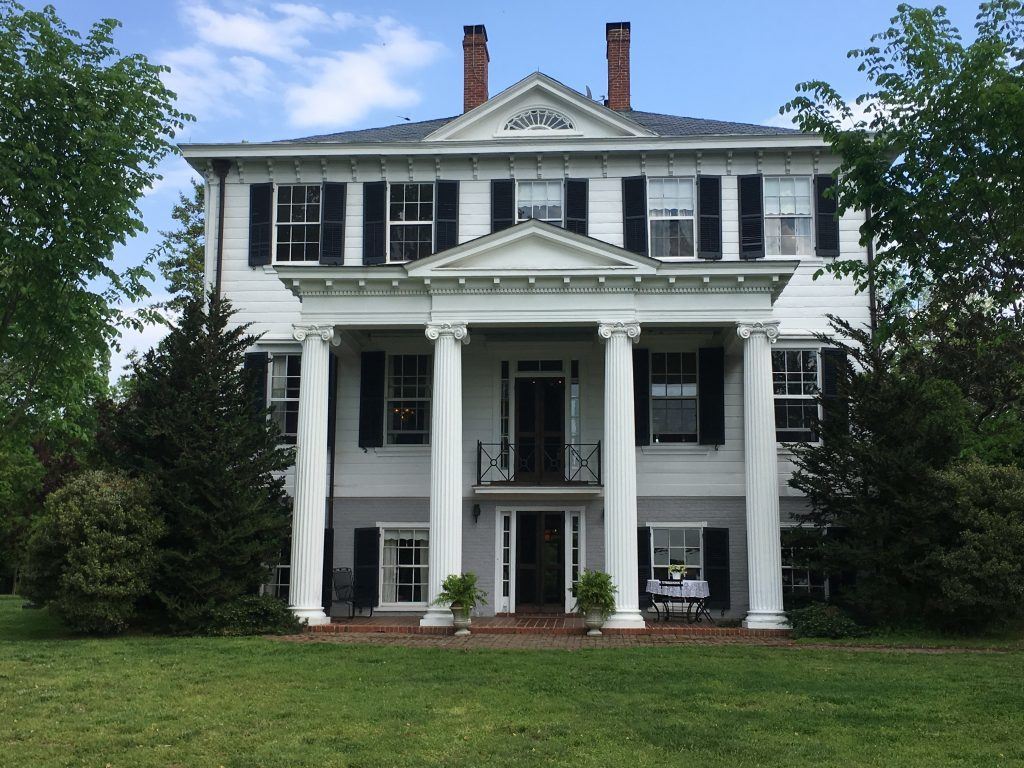
The farm’s Greek-revival house was built in 1860 (the original home burned down) by John Pleasant Royall and his wife, Mary Howell Douthat. Above is the west facade, facing the river. Below is the east facade.
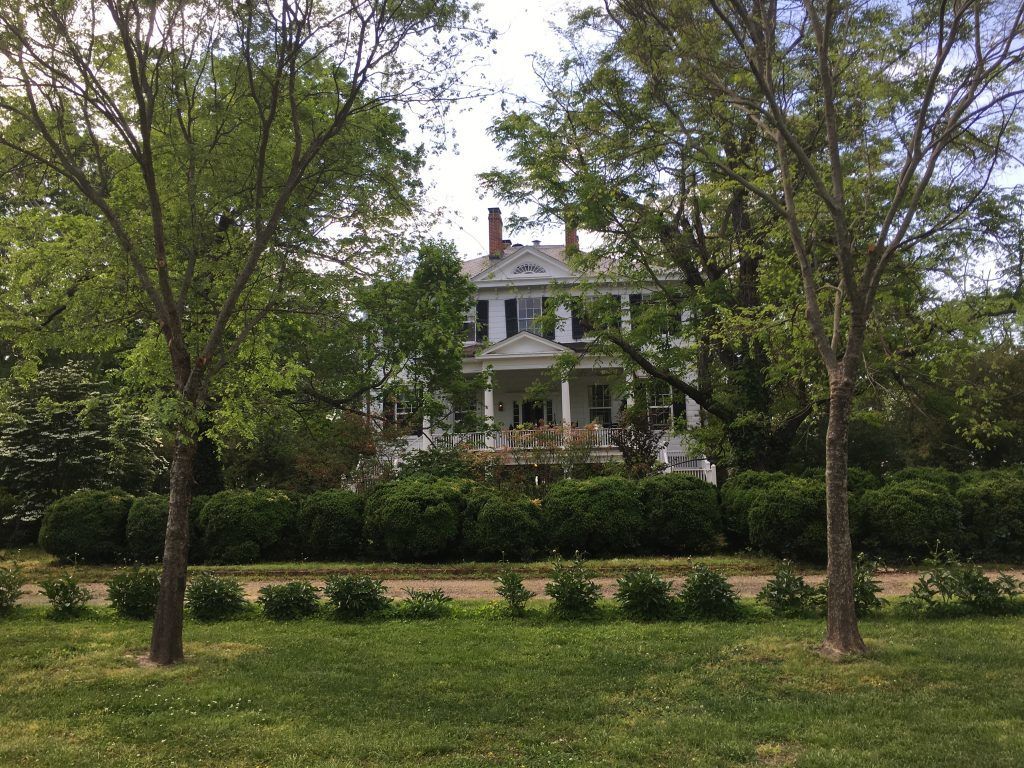
Looking east from the house is the largest Boxwood (below) I’ve ever seen.
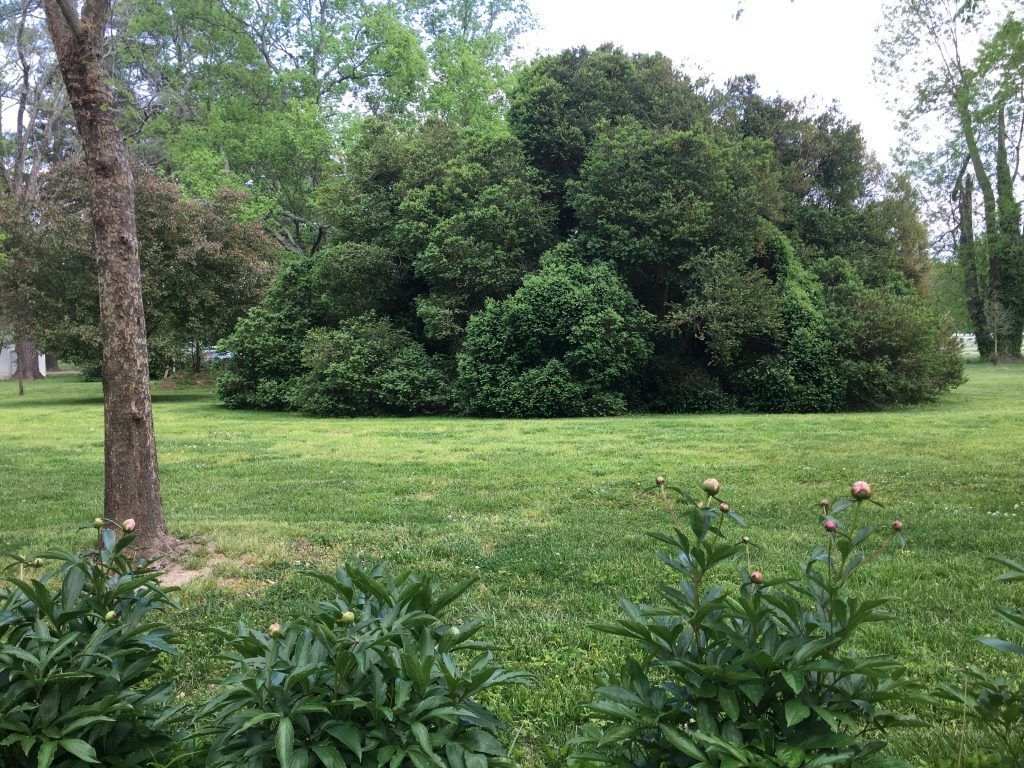 I couldn’t believe this ginormous plant was born of one shrub, so I entered the Boxwood forest to check it out (below). It appears that it is, in fact, the outgrowth from one plant. Wow, what a time the Nordt kids must have playing beneath this canopy.
I couldn’t believe this ginormous plant was born of one shrub, so I entered the Boxwood forest to check it out (below). It appears that it is, in fact, the outgrowth from one plant. Wow, what a time the Nordt kids must have playing beneath this canopy.
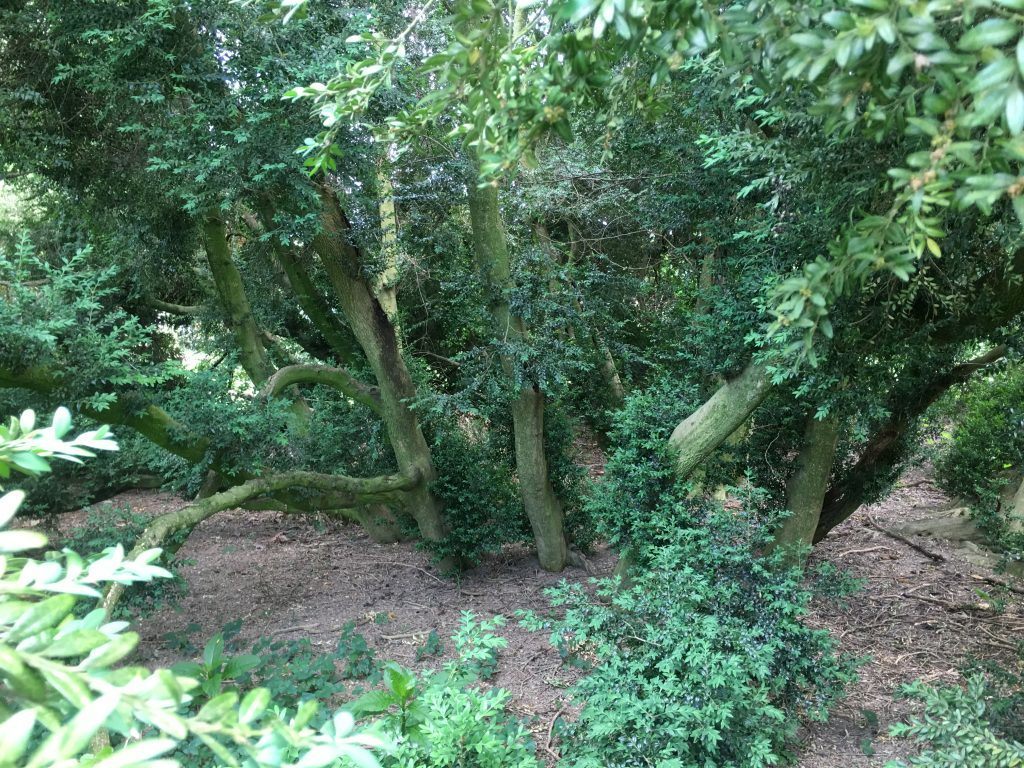
A Charles Gillette garden was installed along the riverfront in 1927.
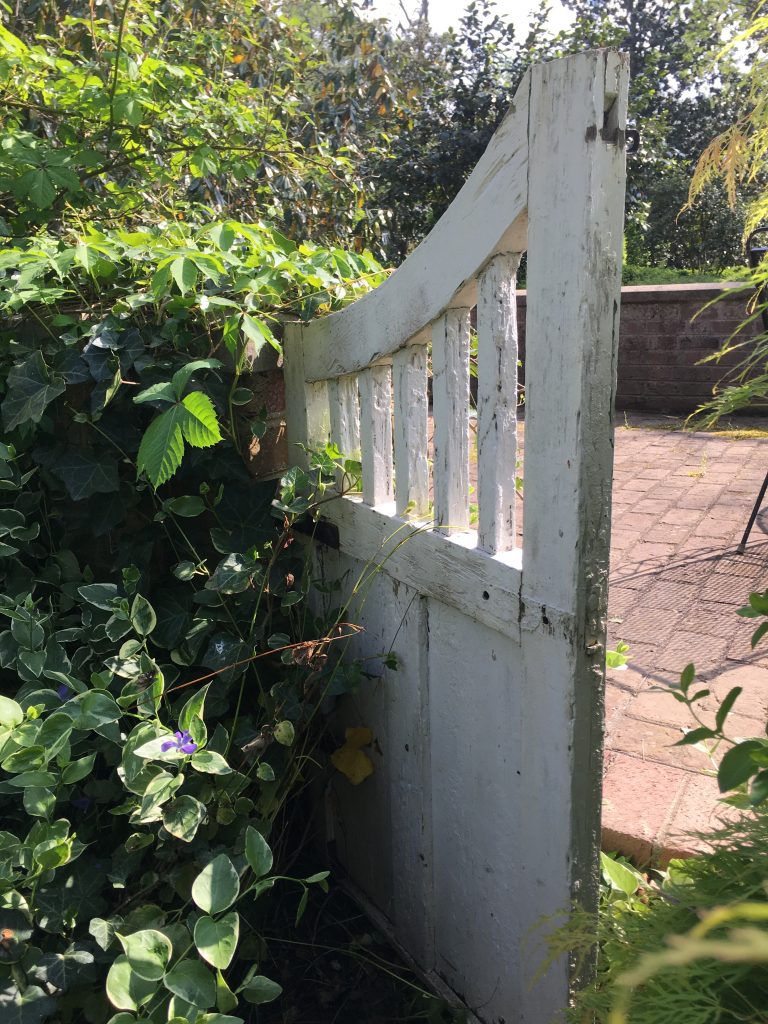
A boxwood parterre and brick walkways are enclosed within a brick serpentine wall.
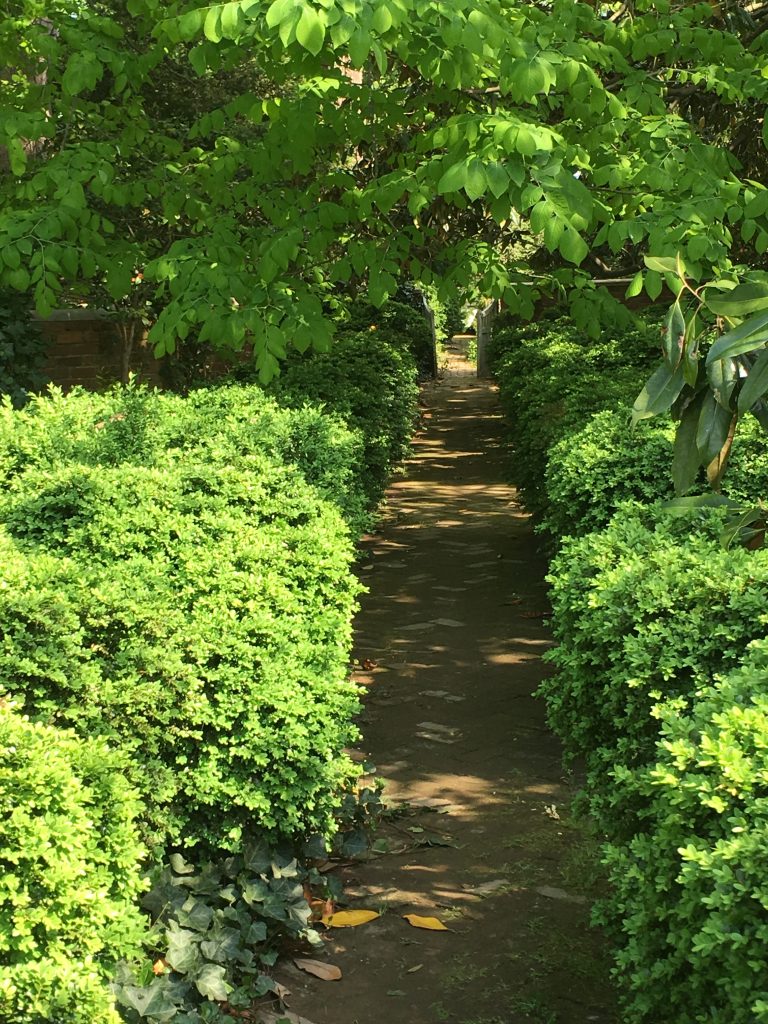 I ran into the Nordts while walking the grounds, and learned that Bill is crazy for trees. How lucky for Riverview Farm that he is! The property contains many old native specimens, such as the Yellowwood (Cladrastis kentukea), below.
I ran into the Nordts while walking the grounds, and learned that Bill is crazy for trees. How lucky for Riverview Farm that he is! The property contains many old native specimens, such as the Yellowwood (Cladrastis kentukea), below.
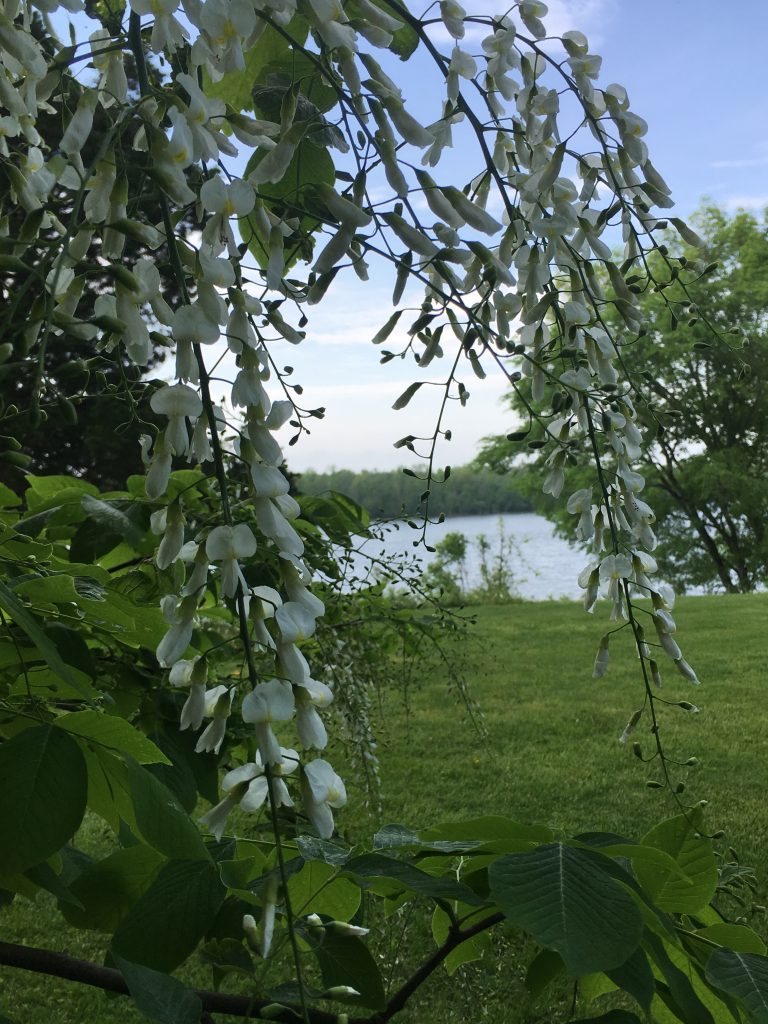 The Nordts have planted more Yellowwood, as well as other native species, including Fringe Tree (Chionanthus virginicus) and River Birch (Betula nigra), below. He gets most of his trees from Bremo Trees, a fabulous nursery on another historic piece of land, further west along the James near Fork Union.
The Nordts have planted more Yellowwood, as well as other native species, including Fringe Tree (Chionanthus virginicus) and River Birch (Betula nigra), below. He gets most of his trees from Bremo Trees, a fabulous nursery on another historic piece of land, further west along the James near Fork Union.
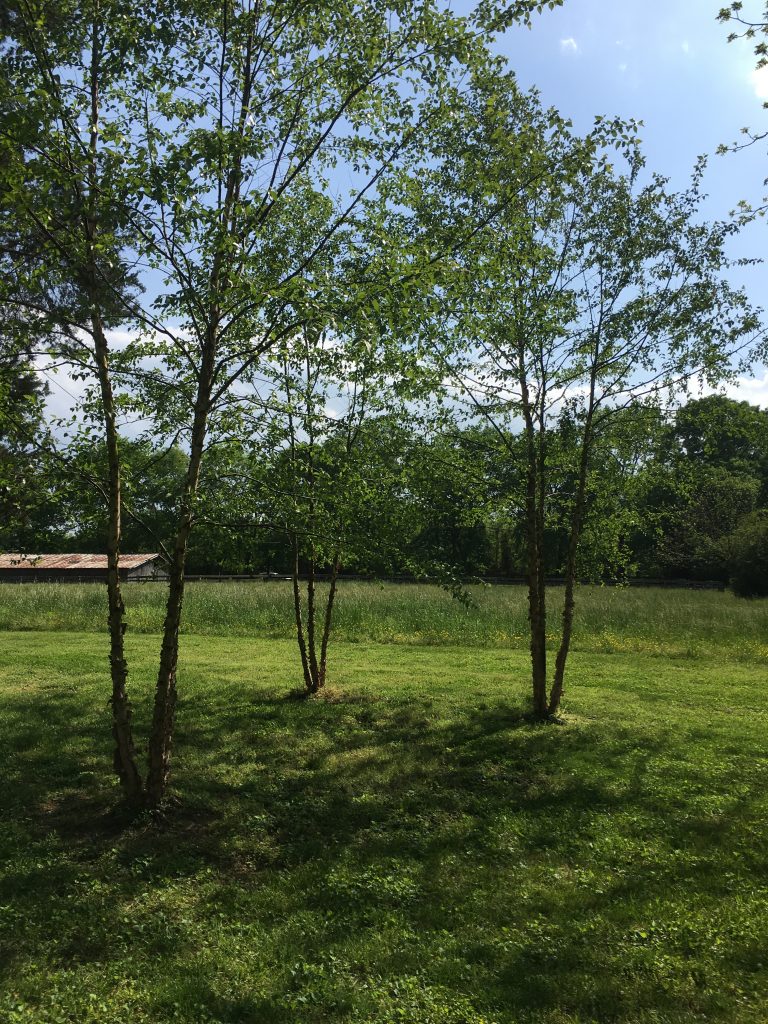
As Bill continues to populate his farm with native trees, the invasives that plague the Virginia landscape work hard to overtake the natives along the river bank. Below, Tree of Heaven (Ailanthus altisssima) and Multiflora Rose (Rosa multiflora) muscle their way onto the scene.
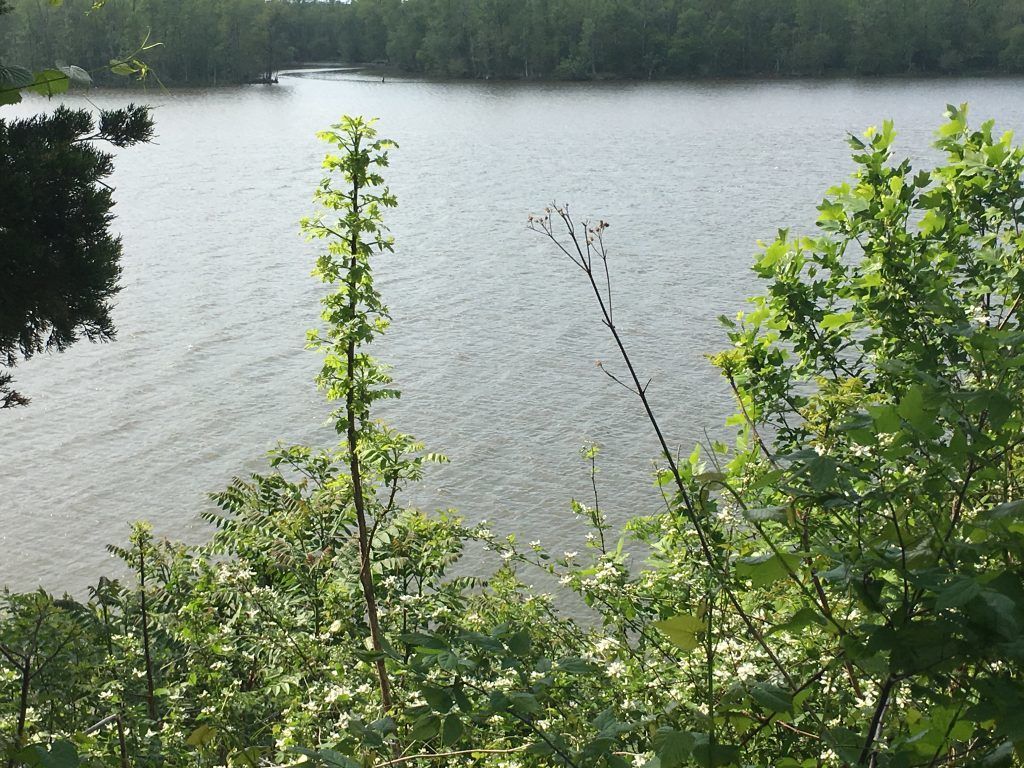
Both of those plants are in the Top 10 of invasive species that the James River Park Invasives Task Force, of which I’m a member, is working to control. For those interested in tackling the invasives in the park, many volunteer opportunities are posted on the brand-new website.
When the kids get tired of playing under the canopy of the Boxwood, they can climb into the canopy of this Green Ash (Fraxinus pennsylvanica) where the penultimate tree house awaits them.
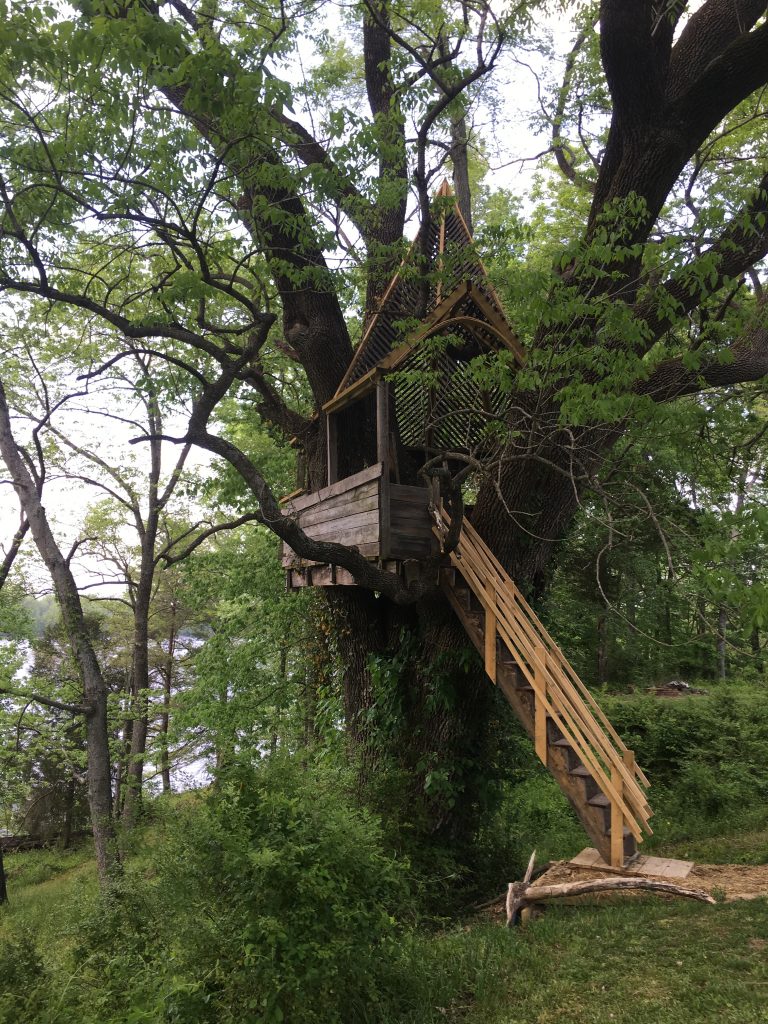 During last year’s Garden Week, I did a blog post on Westover Plantation, and was struck by the Erda family’s connection to the land, the history, and the natural beauty surrounding them. As today’s kids suffer from a nature deficit, these kids spend their days exploring, discovering, soaking in beauty, and putting in good old fashioned labor.
During last year’s Garden Week, I did a blog post on Westover Plantation, and was struck by the Erda family’s connection to the land, the history, and the natural beauty surrounding them. As today’s kids suffer from a nature deficit, these kids spend their days exploring, discovering, soaking in beauty, and putting in good old fashioned labor.
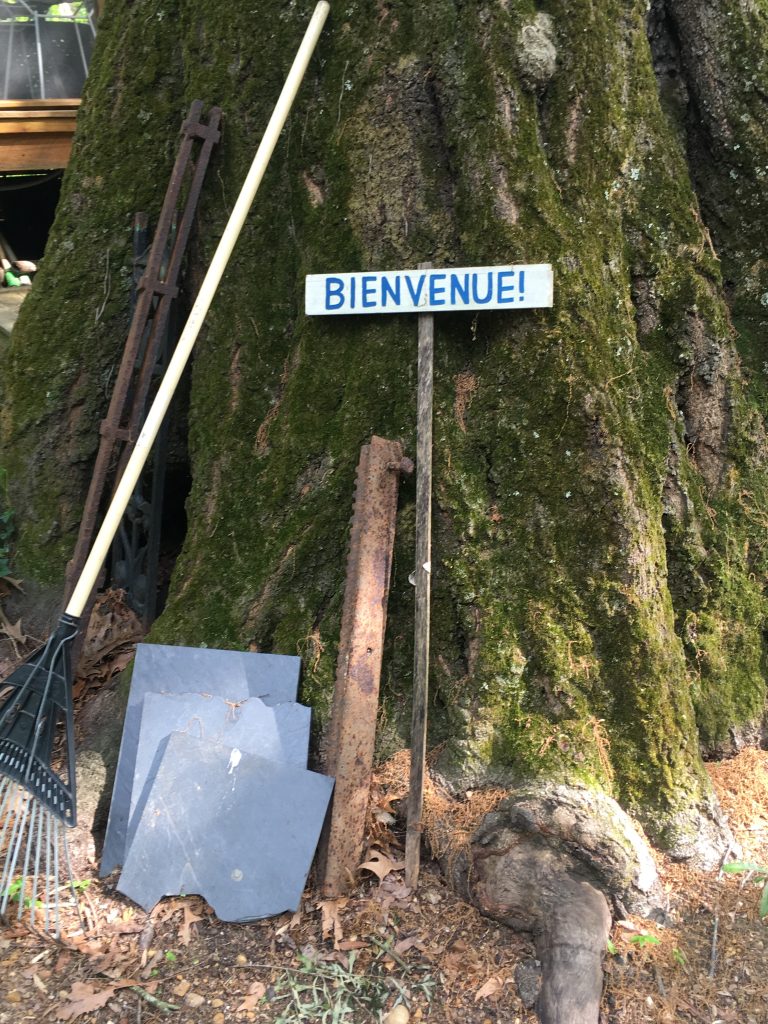
I was reminded of this when reading the Nordt Family Farm website, in which Dianne Nordt writes, “So now I’m a weaver, living on a farm, raising kids and sheep. Together with my incredible husband, we manage an old house and a 400 acre farm on the banks of the James River in Charles City County, Virginia. I feel so fortunate to live my dream, to stay at home with my kids, and to practice the craft that I love to my core.”
About that weaving . . .
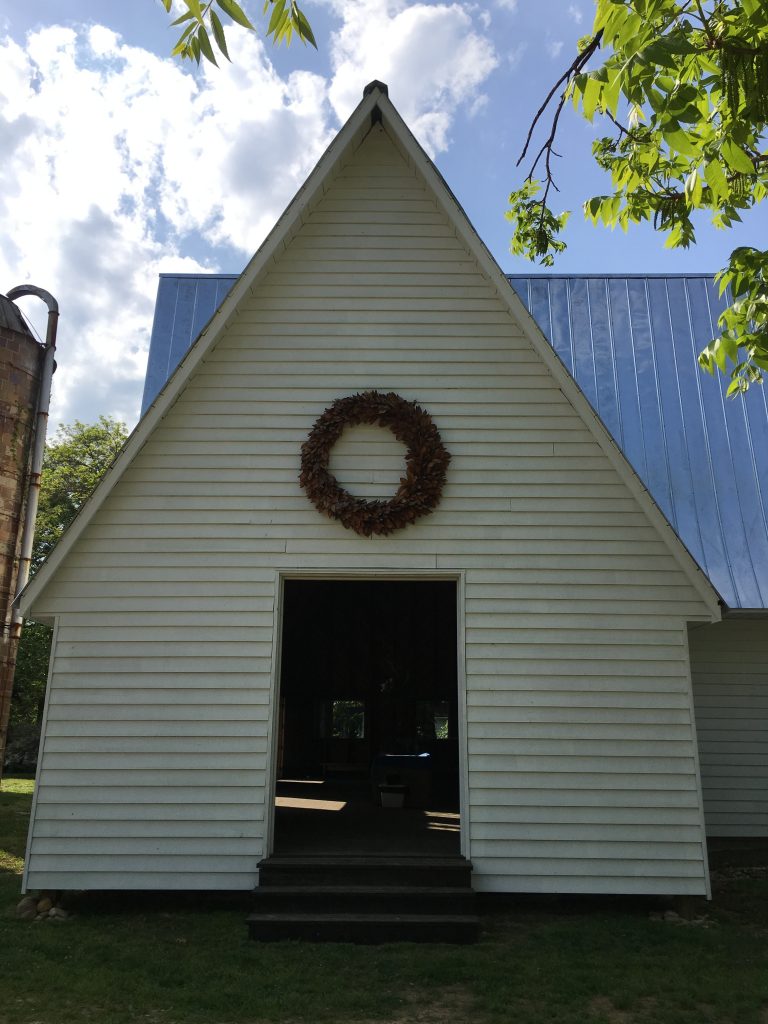
In Dianne’s words, “I appreciate a lifestyle that grounds me to home. My natural media, Merino wool and plant dyes, are nourished from the southern ground whose landscape inspires me. And my weaving mimics the pace of life here, slow and contemplative.”
Dianne found her passion for weaving while studying fashion design at VCU.How could the blankets Dianne weaves be anything but elegantly understated, when the sheep whose wool she shears live in a barn (above and below) which reflects that same aesthetic?
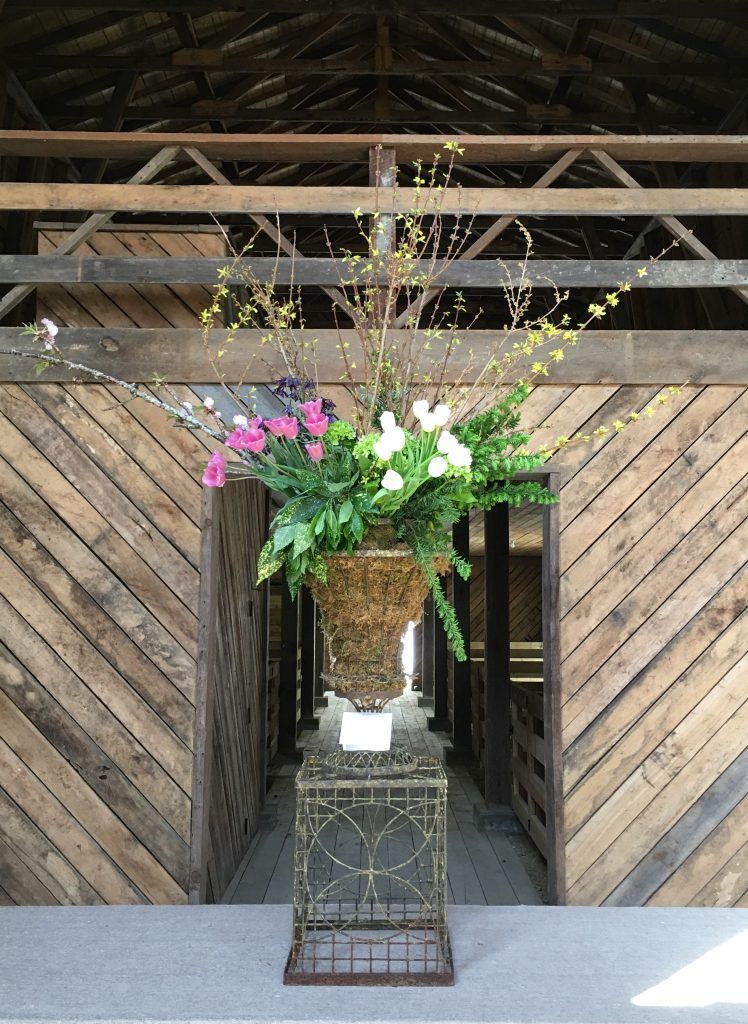
The Nordts tend a vegetable garden (below). Dianne uses plants grown on the farm to make the dyes for the wool.
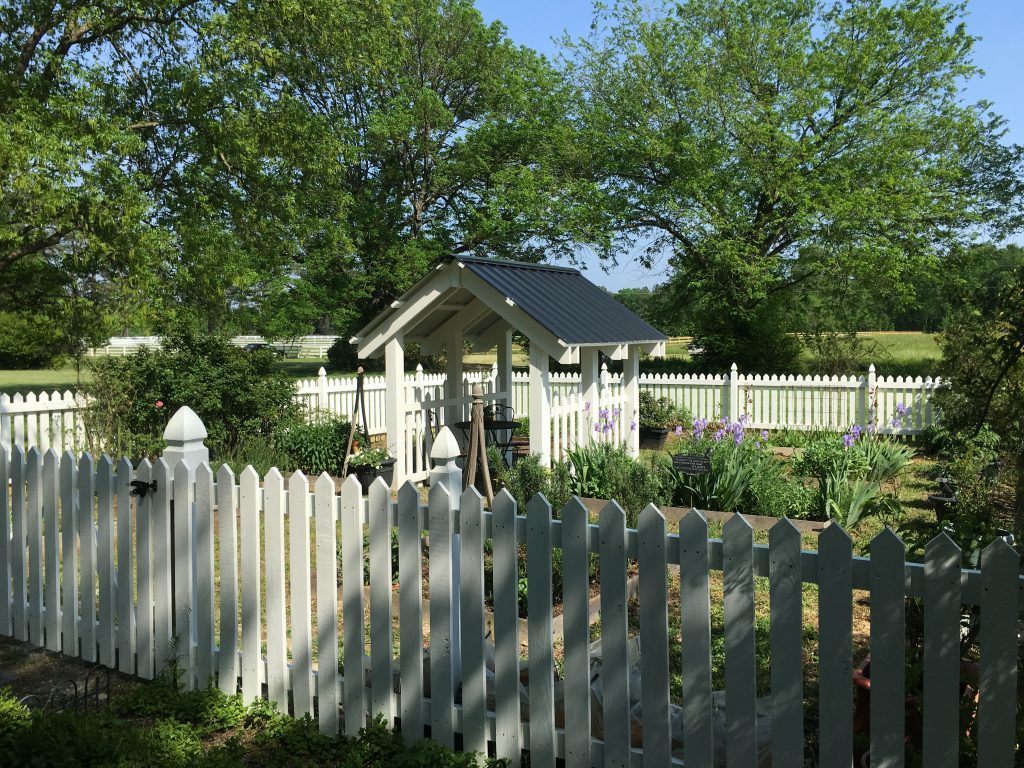
The Nordts also grow soybeans, corn, cotton, wheat and hay. Below, Boston Ivy (Parthenocissus tricuspidata) climbs a silo.
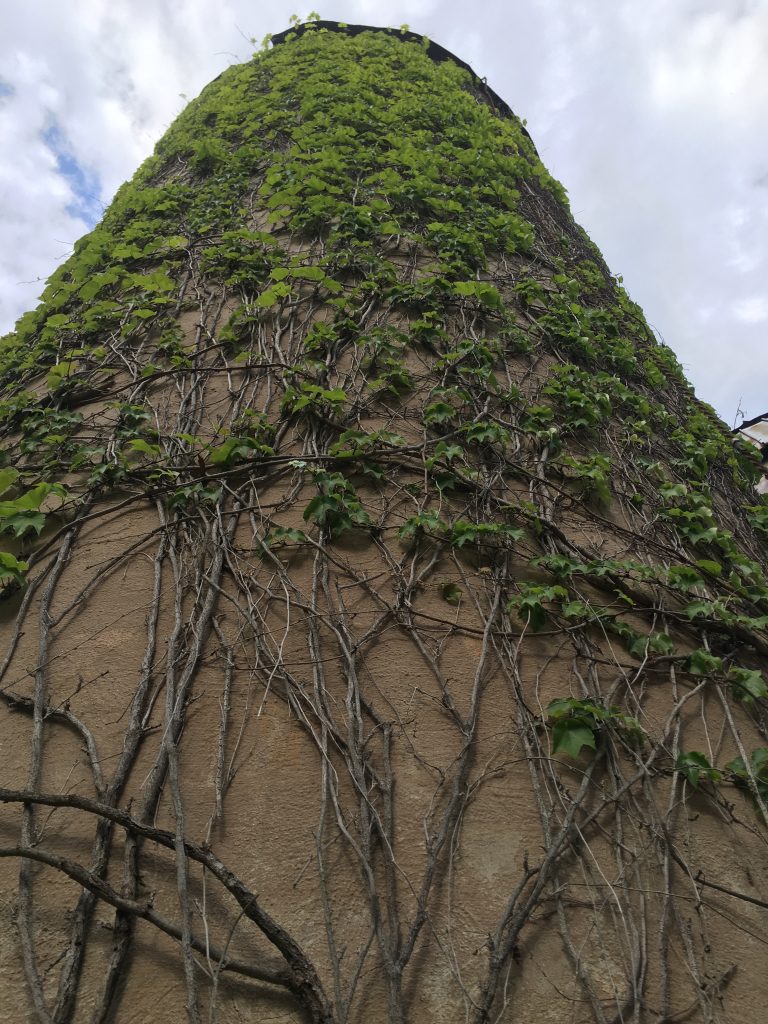
A barrel catches rain water from the roof of the stables, below.
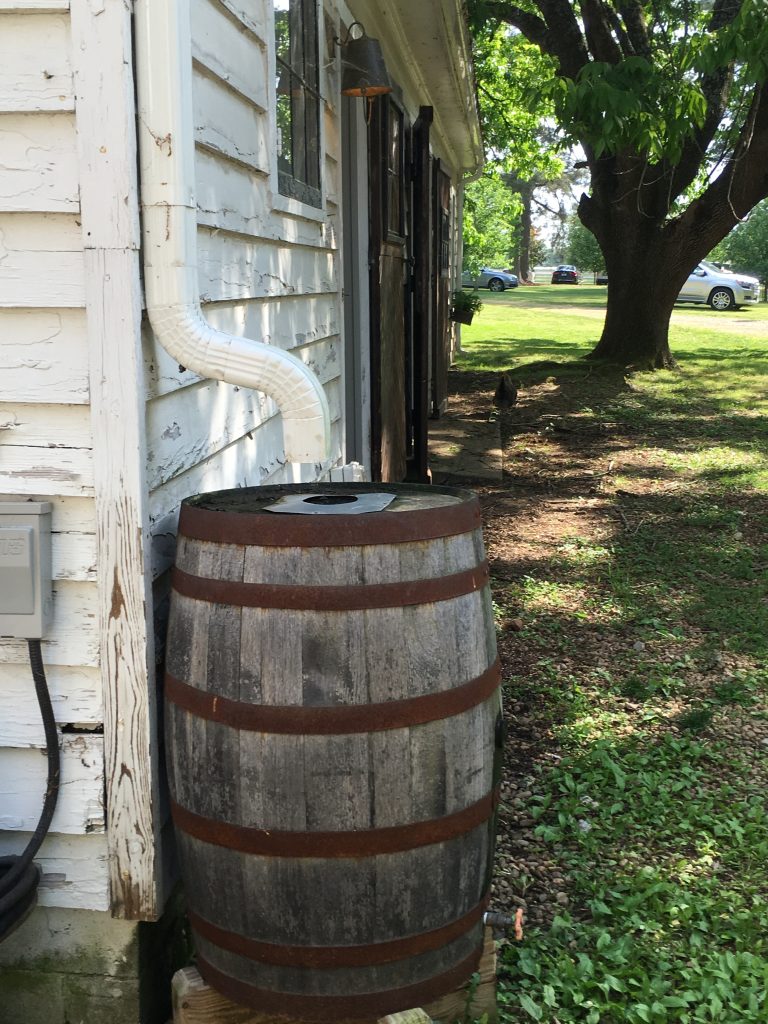
I left Riverview Farm grateful for the Nordt family’s devotion to preserving this historic sweep of land along the James. By nurturing the plants that have thrived there for centuries, planting to ensure the habitat continues to thrive in the future, continuing the centuries-old practice of farming the fields, and reinvigorating the time-honored craft of weaving hand-dyed wool, the Nordts are instilling in the next generation a love and respect for this increasingly fragile environment, and hopefully, a desire to pass it on to future generations of Virginians.
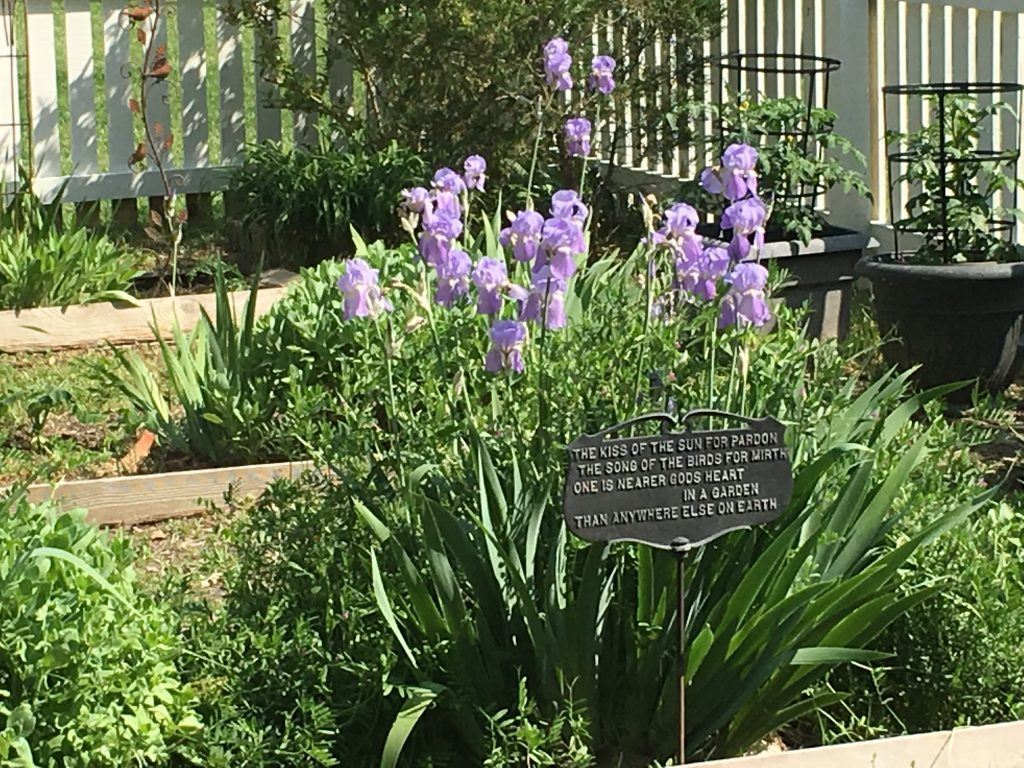
For more information about life at Riverview Farm, follow owner Dianne Nordt’s instagram postings, found at #nordtfamilyfarm.
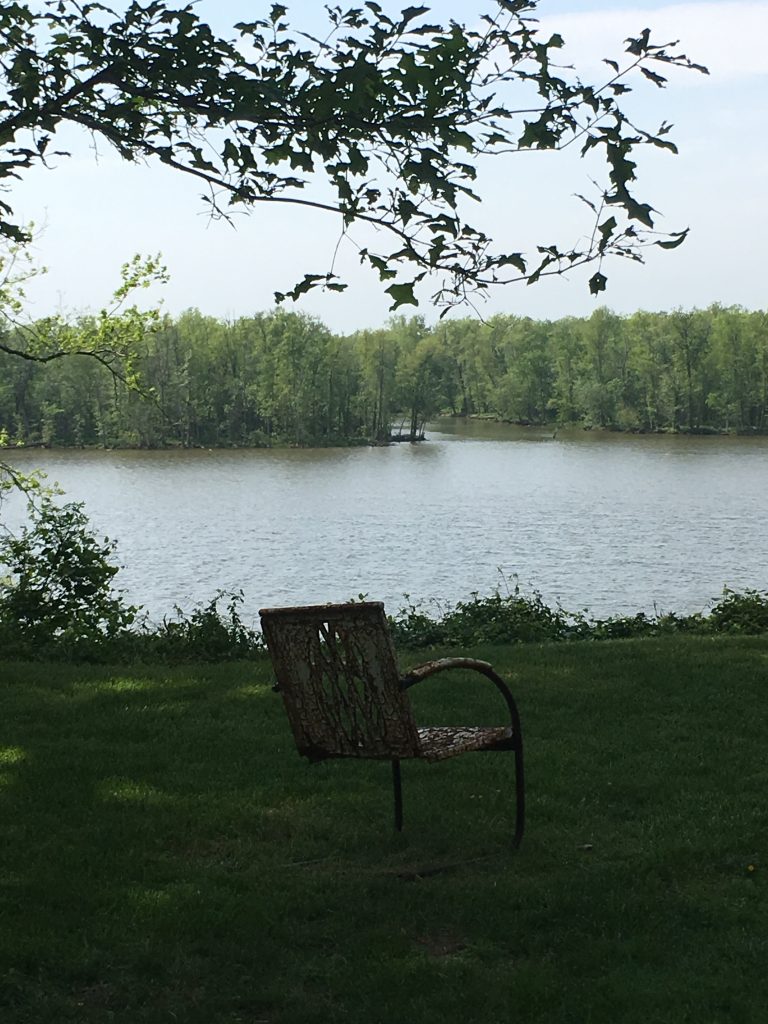
[custom-related-posts title=”Related Posts” none_text=”None found” order_by=”title” order=”ASC”]
HELP STOP THE CRAPE MAIMING!
It’s time for my yearly cry for mercy.
Every winter, my normally low blood pressure shoots skyward, as the Crape Maiming season begins in earnest. I fancy becoming a Crape Maiming vigilante every January, but, after being chased down the street by an ogre of a “pruner” once, I’ve wimped out on that front. So please, help me spread the word that our beloved Crapemyrtles are being senselessly butchered every year, depriving us of one of the pleasures of the cultivated landscape. Join my Facebook and Instagram campaigns, and post your own sightings.
I just missed the perps who committed this horrific maiming. Note the fresh sawdust mulching the ground.
The Crapemyrtle (Lagerstroemia indica) is one of those special trees that provides four seasons of interest. In spring, the leaves emerge late, casting filtered sunlight below. In summer, the flowers cover the tree for up to two months. In fall, most Crapes have outstanding red or orange foliage that persists (much to the chagrin of leaf rakers) almost until December. In Winter, a properly pruned tree is one of the season’s most striking silhouettes in the garden, with its gracefully tapering branches and mottled bark.
WHAT IS CRAPE MAIMING?
Crape maiming is the practice of topping a Crapemyrtle during dormancy. Crape Murder is the most popular term used for this butchery. The lawyer in me calls it maiming, because the severe pruning rarely kills these tough trees. Instead it disfigures them.
Crape maiming occurs when a pruner tops — or prunes — each of the tree’s branches, stopping short of a bisecting branch. You see the cut backs in varying degrees. The tree above has the antlers look.
My guess is that the landscaper who pruned the trees pictured above, at Short Pump Town Center, thinks he did not commit Crape Maiming, because he only cut the spent flower stalks. But he is wrong. This is also maiming, and it ruins what could be a beautiful winter vista. The only thing this pruning accomplished is putting extra money in the landscaper’s pockets for doing unnecessary work.
I don’t know whether to laugh or cry at this hatchet job.
WHY OH WHY DO THEY DO IT?
Why the maiming? I hear two excuses. First, it is claimed that a Crape must be topped so that it will produce more blooms. At some point, somebody put the Crape in the category of Butterfly Bush (Buddleia davidii), Beautyberry (Callicarpa americana), Annabelle Hydrangea (Hydrangea arborescens) and Limelight Hydrangea (H. paniculata). Those plants do benefit from aggressive late winter/early spring pruning. But a Crape, if planted in the right place, will bloom profusely year after year without such topping or aggressive hacking. We don’t top Dogwoods, another tree with a graceful branching habit, so why do we do it to Crapes?
Second, Crapes are topped because they are too big for the places they were planted. If a shrub or tree needs to be pruned on a yearly basis because it is outgrowing its spot, it needs to be replaced with a plant that has room to grow to its mature height and width.
The beautiful grove of Crapemyrtles above, at Furman College, are the result of proper Crape pruning.
HOW TO PRUNE A CRAPE
This pruning, during the tree’s dormancy, will give your Crape a light, airy appearance:
1. Cut any suckers to the ground that grow from the base of the tree.
2. Cut out any diseased or dead branches.
3. Prune any branch crossing or rubbing against another.
4. Remove shoots growing into the center of the tree, and remove any wayward, awkwardly growing branches to create more open space and allow sunlight and air to penetrate.
5. Cut back spindly branches at the intersection of a lower growing branch.
Sweetbay Magnolia (Magnolia virginiana), Saucer (or Tulip) Magnolia (Magnolia x soulangeana), Japanese Maple (Acer palmatum) and Chastetree (Vitex agnus-castus), pictured below, also benefit from these pruning techniques.
The Crapemyrtle below, in Charleston, South Carolina, has been selectively thinned to allow it to grow close to the house and the sidewalk.
The Crape below exemplifies the dormant look of a tree that is topped yearly. The poor tree is bracing itself for this year’s hacking.
What would you rather see in the winter landscape?
This?
Or this?
CRAPE CULTURE
Crapemyrtles thrive in full sun and well drained soil. They benefit from an amendment of the soil with compost, but they do fine in average soil too. Once established, Crapes are drought-tolerant.
One word of caution when planting a Crapemyrtle: avoid planting it near terraces, driveways and pools. I hated Crapes when I lived in Charleston, because I parked under one at the courthouse. The dark pink blooms covered my car everyday, the humidity giving it a nice decoupage look.
While every tree sheds something at some time, Crapes shed spent blooms beginning in July (depending on the cultivar and that season’s weather), continuing into fall, followed soon after by the leaves, which also shed over a long period of time. Thus, you will be continually sweeping or blowing your terrace or driveway from July to November. Better to plant the Crape where you can enjoy its beauty without cursing its natural cycles.
CHOOSE THE RIGHT CULTIVAR FOR YOUR GARDEN
There are scores of cultivars from which to choose. Crape cultivars are available as shrubs, small trees and towering 30 footers. Bloom colors range from white to pink to purple. Take note of a tree’s mature height and width, its color, whether it has exfoliating bark, and whether it is resistant to disease when choosing your Crape.
Here are a few exceptional choices, all with good disease resistance:
Osage: 10-20 feet, clear pink
Sioux: 10-20 feet, vibrant pink
Natchez: over 20 feet, white
Tuskegee: over 20 feet, dark pink
Muskogee: over 20 feet, lavender
Biloxi: over 20 feet, pale pink
Choctaw: over 20 feet, bright pink
For more information on selection and care of Crapemyrtles, check out the Virginia Cooperative Extension Service’s report.
For those of you who wonder whether a Crape that has been maimed can be rejuvenated, I offer you this tree in my back yard. Note the “knuckles” in the tree where cuts were made many years ago. While this tree will always bear the scars of the long-ago hatchet job, it is shaping up pretty nicely (but is in need of thinning the spindlies). As for the ragamuffins dwelling in the tree, they’re Trouble.
[custom-related-posts title=”Related Posts” none_text=”None found” order_by=”title” order=”ASC”]














